Costa Coffee is now open in The Retail Park Liffey Valley
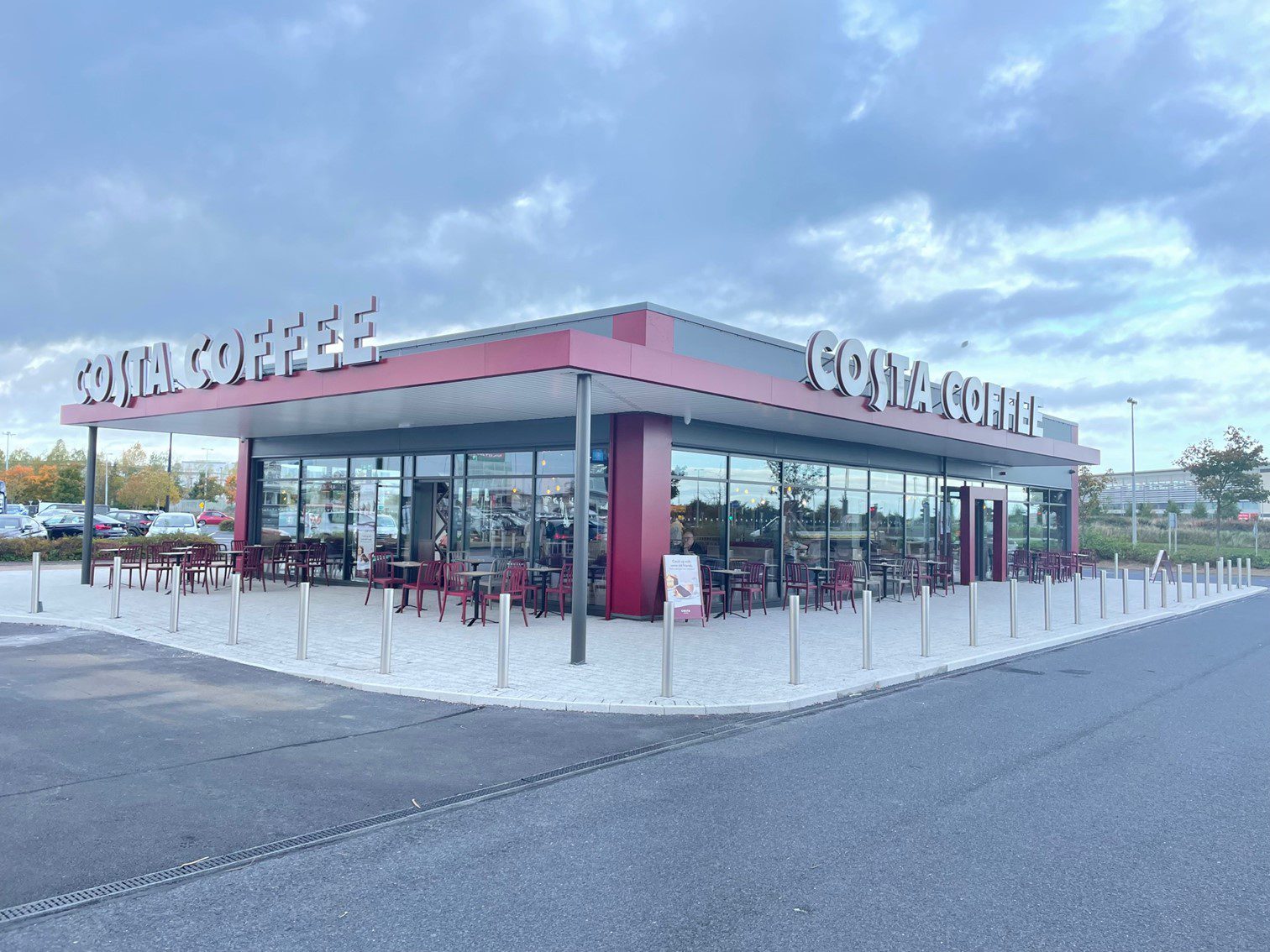
Bannon are delighted to announce the opening of Costa Coffee at The Retail Park Liffey Valley in their new bespoke coffee pod.

Bannon are delighted to announce the opening of Costa Coffee at The Retail Park Liffey Valley in their new bespoke coffee pod.
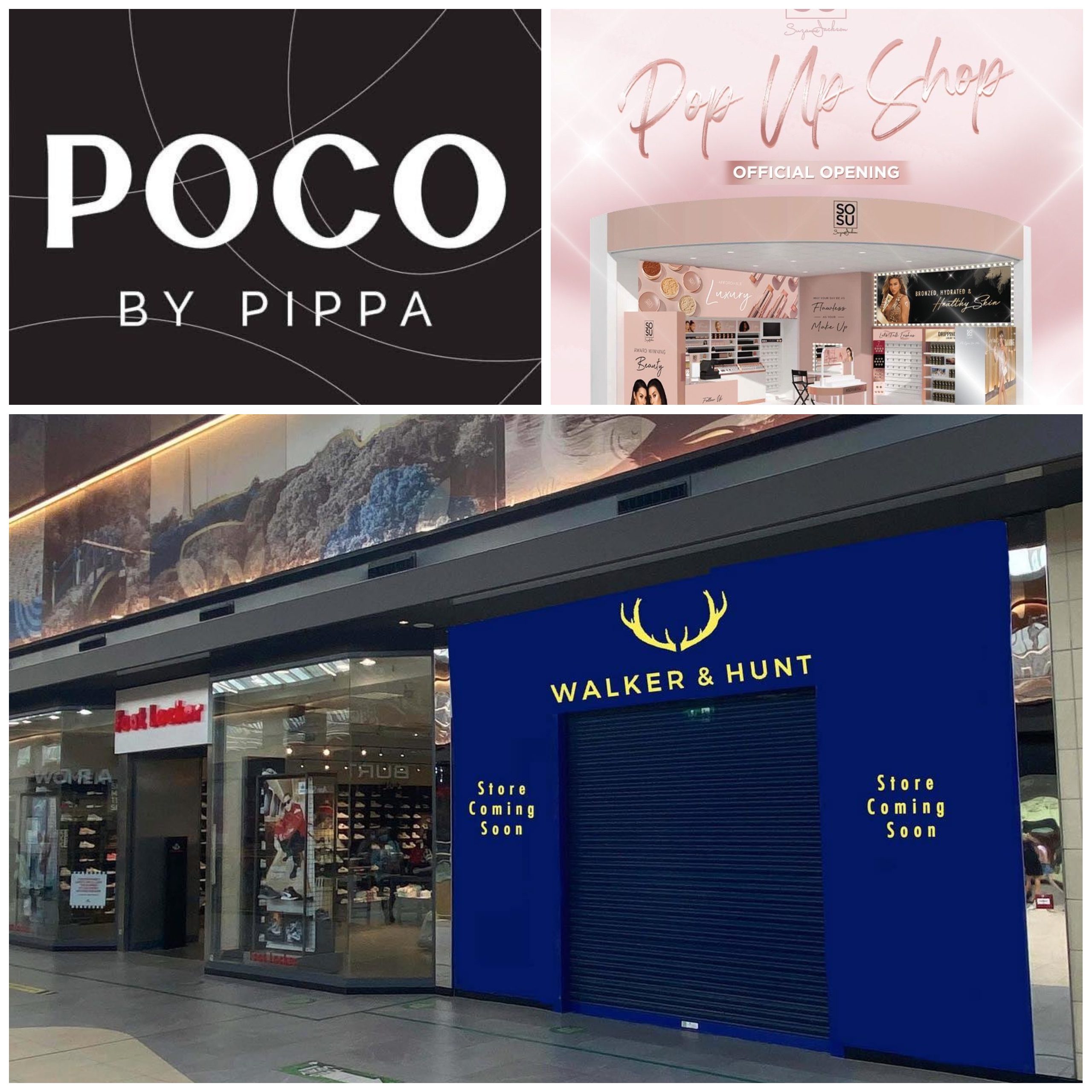

Some of the Bannon team inspecting Fitzwilliam 28 this week which is nearing PC. The new ESB Headquarters raises the bar for sustainable office development in Ireland. Proud to have been part of the team to bring this exciting development to fruition since 2011.

Roderick Nowlan and Neil Bannon back on the conference circuit again. Great to be back at EXPO REAL meeting people in person.
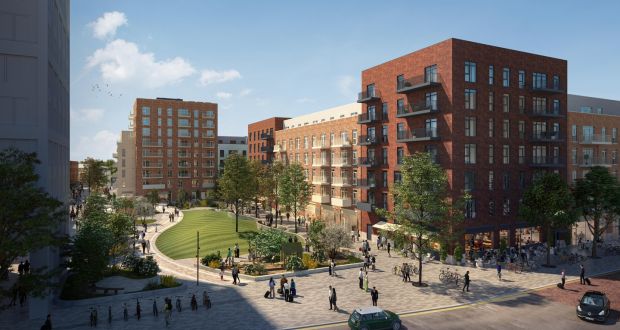
Called The Crossings, Quintain’s first phase of development at the new urban centre in Adamstown will include 279 apartments and more than 91,000sq ft/8,500sq m of space to house two major supermarkets, 20 retail units and five restaurant outlets, along with a multi-storey car park.
Quintain is the housebuilding unit of US private equity giant Lone Star, which has accumulated a massive Irish landbank.
Construction of the apartments has a completion date of mid-2023. Planning permission for a second phase of 185 apartments has been granted and further phases are planned for submission in late 2021 and early 2022.
Quintain has a buyer lined up for the first tranche of its buy-to-rent scheme but Eddie Byrne, joint managing partner with the developer, says “it’s too early to say who it is”.
Getting this forward funding is key to the construction of such a developments, he says. “You really need to be able to have a buyer lined up in advance.” The Crossings will form an integral part of a new urban centre at Adamstown, which, over the next four to five years, will see the construction by Quintain of almost 1,000 residential units, mostly apartments/duplexes, with a “very small number of houses”.
On the retail side, Tesco has signed a lease for a 40,000sq ft/3,700sq m store, which is set to open in January 2023, with a second leading supermarket anchor store set to open a
Bannon has been retained as agents for the leasing of the retail units, which will serve an estimated potential shopping population of more than 100,000 people drawn from Adamstown, and the neighbouring suburbs of Lucan, Celbridge and Leixlip.t the same time.
To date, Quintain and its affiliates have built 1,000 homes in Adamstown, with over 85 per cent occupied by first-time buyers, launching developments such as Tandy’s Lane and Somerton.
Earlier this year it received planning permission to construct 235 new homes at Aderrig in Adamstown, to include 159 houses and 76 apartments. The scale of its total investment in the area is expected to be north of about €3 billion.
In June, Quintain completed and transferred ownership to South Dublin County Council of Tandy’s Lane Park, which will provide local residents with easy access to green open space. Another 27-acre green open space – Airlie Park – is set to open by the end of the year and will include a cricket pitch and Astroturf pitches, while a two-acre village green will provide a centre piece for The Crossings development.
Michael Hynes, joint managing partner with Quintain Ireland, said, “This investment will contribute to the social fabric of the area, and is supported by the handover of Tandy’s Lane Park to South Dublin County Council. We are very confident in the strong level of demand there is to live in the area, which will be boosted by the new amenities we are delivering.”
Quintain owns 220 acres in the Adamstown/Lucan area, where it plans to develop up to 5,000 new homes and 250,000sq ft of commercial space. The company’s broader land portfolio covers 460 acres of prime assets in Ireland at Adamstown, Clonburris, Portmarnock, and Cherrywood.
Adamstown was launched in 2005 as Ireland’s first new planned town since Shannon, Co Clare, in the 1960s.
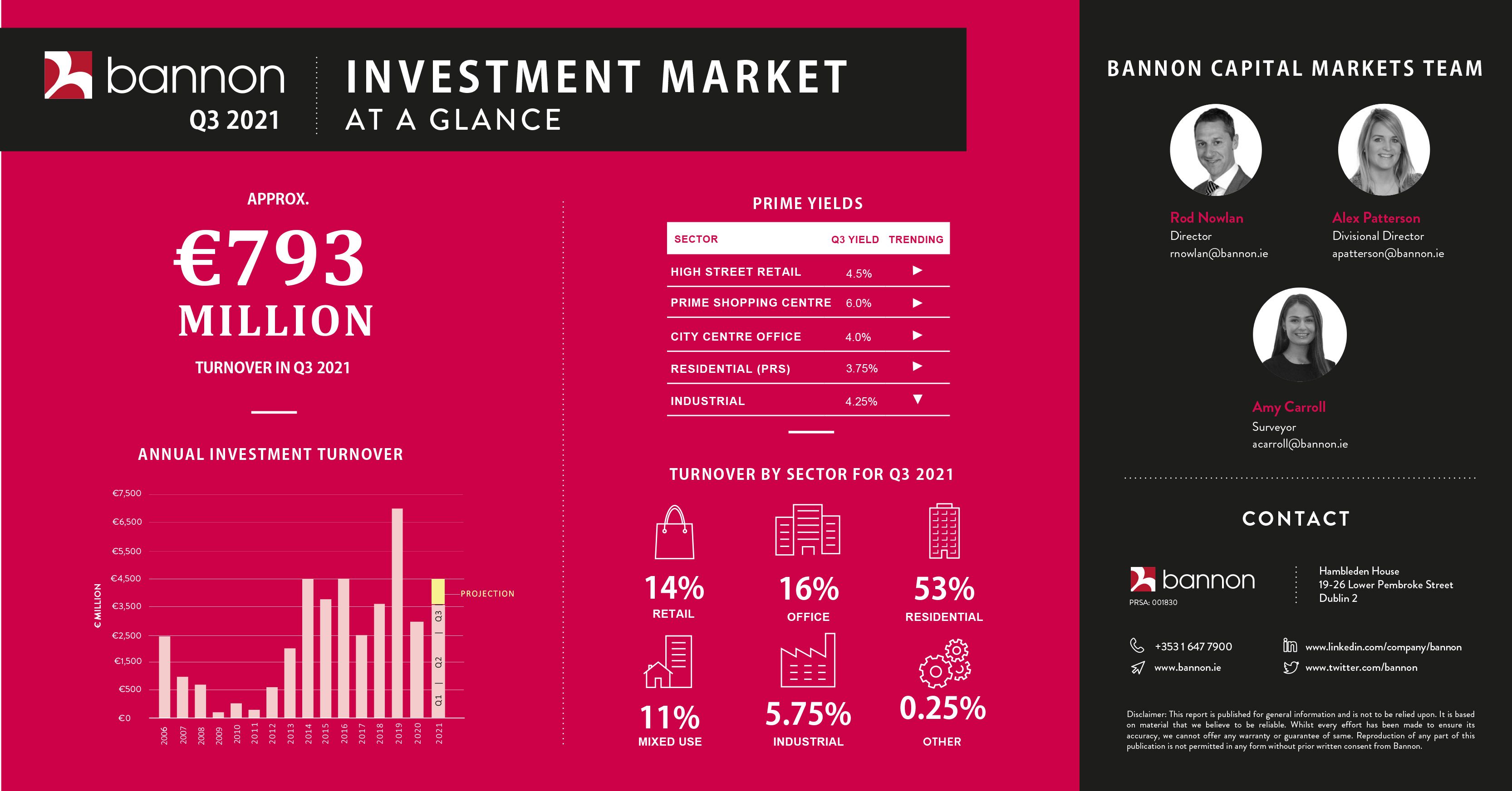
The Bannon Capital Markets snapshot highlights that the Retail Sector has finally emerged from the shadows at 14% of Q3 turnover of €794m …..but PRS remains the dominant player @ 50%. While Q3 was always going to struggle to match the pent up demand that emerged in Q2 @ €1.5bn, the outlook remains very strong. There is approx. €1.3bn on the market or at agreed stage which leaves our projection of €4.5bn for 2021 intact, an annual out-turn that will only have been surpassed once (in 2019)!
The retail industry in Ireland employs c285,000 people. That is 12.5% of the working population. As leaders in the sector, we are very proud at Bannon to manage over 50 shopping destinations across the country. These destinations are home to over 1,100 businesses who in turn employ 10’s of thousands of local people. Supporting trade locally is supporting your local community. As we reset after COVID, make the right choice, shop local.
Take up for Q3 has exceeded 460,000 sq.ft. across 53 transactions. This represents a 92% increase on Q3 2020 but more importantly a 26% increase on Q3 2019 (pre covid).
This quarter has seen a significant jump in activity in the suburbs, particularly in the South Suburbs which accounted for 41% of all transactions.
As we enter Q4 there is over 1,000,000 sq.ft. reserved, this coupled with an increase in active requirements and the continuation of a phased return to the office should bode well for the office market for the remainder of the year.
 Great to get back to Munich for Expo (11-13th Oct) for Roderick Nowlan and Neil Bannon.
Great to get back to Munich for Expo (11-13th Oct) for Roderick Nowlan and Neil Bannon.
Get in touch for a chat on Irish Real Estate Opportunities and the impact of ESG on the Irish market.

The ‘Office’ has featured heavily in the press over the past 18 months and indeed in everyday conversation, as working from home became a necessity for most office-based employees. Countless articles and blogs have been published with sensationalised headlines such as “What will the office market look like after the great remote working experiment?” to “Productivity of remote workers could determine the fate of the office market”.
Our view is that the office will now assume a wider function with a more consolidated, improved, and focussed environment to manage the challenges of hybrid working and employee engagement going forward.
Over the last 6 years, Irish office developments have evolved considerably with numerous exceptional schemes being delivered. These buildings have attracted leading global firms to Dublin in particular and the expansion of many more as they continue to increase their presence and EMEA HQs. Due to the new standards set by these firms, occupier expectation has increased which has resulted in developers placing more emphasis on emulating what the tech sector has traditionally offered to their employees: amenity, a perk, a perceived life work balance. They have achieved this through the accumulation of amenity-based facilities such as: high end shower and bicycle facilities, concierge services, tenant events, better reception areas, coffee docks and townhall spaces. This together with improved building standards and environmental and sustainability credentials coming more to the fore has given rise to the creation of world class and award-winning office buildings in Ireland.
However, the office sector is about to enter a new phase. Traditionally offices required a centralised location which has been challenged by technology. Prime offices were traditionally clustered around transport infrastructure in a central business district where multiple advantages of proximity to transport, telecommunication infrastructure and labour combined to attract a premium from occupiers, but technology is challenging the need for multiple office functions to take place in a centralised location. This need must be replaced with desire. The user of the building now places more focus on it being a positive environment for their business and their teams.
Like the revolution that has taken place in the retail market where the ability to shop online challenged traditional assumptions on the functionality of real estate, investors in the office sector must adopt an experience focussed strategy. The nascent breakthroughs the sector has made recently to enhance user experience must be expanded upon, implemented at an early stage in the development process and maintained through a proactive management regime.
As real estate’s function evolves, how do we deliver a successful solution for this next phase in the evolution of the office? As mentioned previously User experience is key and this can be achieved through many innovations. These changes do not have to be seen as challenges but as opportunities to be proactive and differentiate a proposition from that of their competitors.
Through Bannon’s extensive property management portfolio and experience in working as design consultants on several large new schemes, our role in working with investors and developers on identifying and enhancing the user experience for office occupiers and their teams has come into sharp focus.
For the investor the asset cannot be just about place making or achieving optimal rental outcome. An investor must consider it as a longer-term play by exploring tenant optimisation i.e. perhaps leasing a portion of the scheme at lower rents to amenity-based occupiers to carefully coordinate a desired aspirational environment. Correct implementation of property and asset management functions is fundamental, they are key to ensuring the functionality for their occupiers from both a corporate and personnel perspective. Communication with occupiers is essential as creating positive experiences for users of the buildings will in turn lead to greater loyalty and enhanced values.
As we move closer to a return to the office in whatever form, recruitment and retention will continue to be the driving force in office acquisitions. Therefore, to adapt to a hybrid model, promote productivity and engage with the ‘new employee’, the office needs to evolve to reflect what people want to use every day. The era of passive office investment is over.
Lucy Connolly is a Divisional Director at Bannon. She has 15 years’ experience acting for a wide variety of private clients and companies in relation to commercial property, office acquisitions, sales and lettings. Contact Lucy by email on lconnolly@bannon.ie
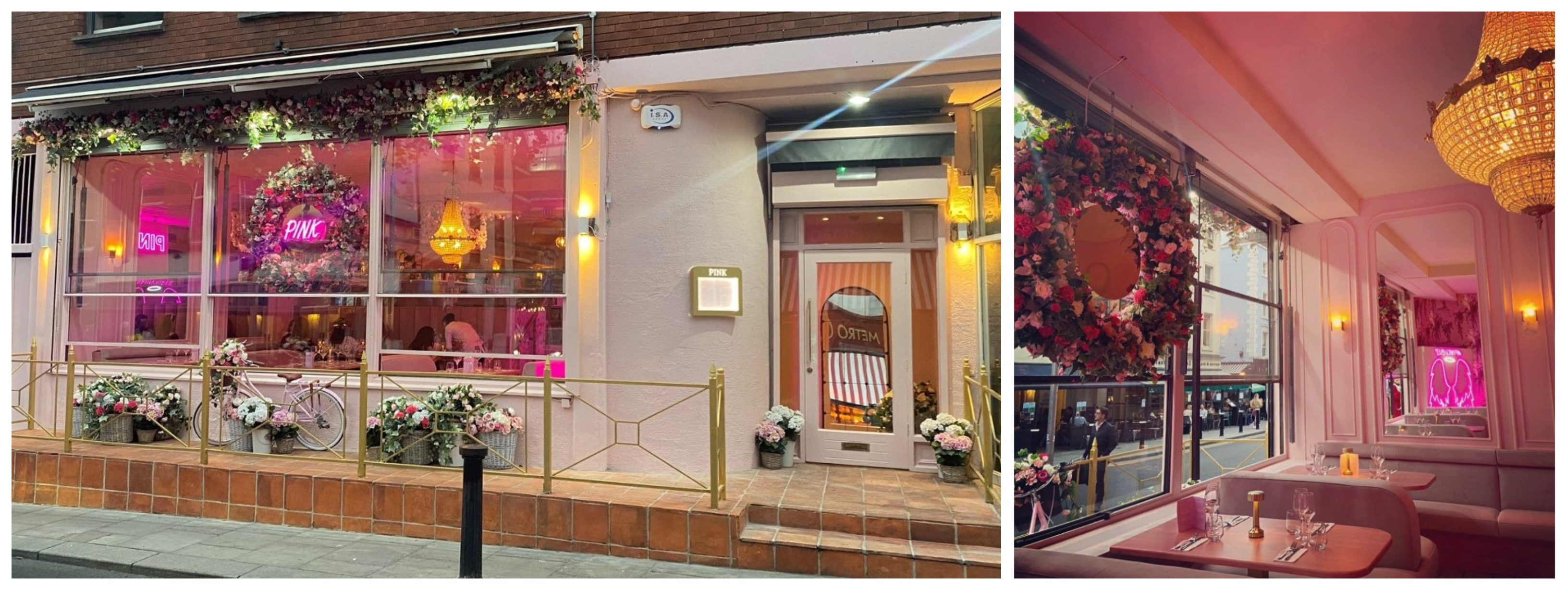
South William Street is getting a blast of colour with the new Oliver Dunne restaurant Pink, which opened its doors yesterday.
This deal started as we entered lockdown 2021 and it showed the belief that a seasoned and experienced operator has in Dublin City Centre trade.
It was a pleasure negotiating the deal on behalf of the landlord and wishing the team in Pink all the best of success for the future.
 The function of all forms of real estate and the specific requirements of its users continues to change at pace. The most significant factors driving this evolution are non-financial – Environmental, Social and Governance (ESG) requirements.
The function of all forms of real estate and the specific requirements of its users continues to change at pace. The most significant factors driving this evolution are non-financial – Environmental, Social and Governance (ESG) requirements.
At Bannon, we are seeing a profound shift from clients towards more sustainable practices. With environmental issues coming to the fore globally and a particular focus of the impact on the real estate sector, Bannon has been proactive in applying innovative and market leading initiatives across assets within our portfolio.
In simple terms sustainability means meeting our own current needs without compromising the ability of future generations to meet their own needs. This encompasses the economy, society and the environment and is often referred to as profits, planet and people.
We know that ESG and sustainability related innovations need to be adopted into every aspect of the management of real estate. Given the scale and variety of assets under our management we are acutely aware of the positive impact changes we implement will have on, the environment and the users of our clients’ buildings.
In partnership with our clients, we have implemented over 40 specific sustainability initiatives in the last 5 years. These initiatives will remove a cumulative 500,000 kg of carbon dioxide annually.
A small sample of the sustainability innovations implemented across our portfolio include:
The focus on sustainability has numerous benefits to all stakeholders and wider society. This ranges from lowering carbon emissions into the atmosphere to a reduction in costs for users of assets. Simultaneously sustainability initiatives provide added value to the assets for investors.
It is very easy to pay lip service to the latest trends in the industry and not take action to back these up. In order to achieve meaningful change, sustainability has to now be at the fore of real estate management. Bannon has recognised this and will continue to work in partnership with all stakeholders to make sure we continue the progress already made.
William Lambe is a Divisional Director with the Property Management team at Bannon.
The Property Management team in Bannon oversees a portfolio of 75 assets for a range of institutional, private equity and private clients.
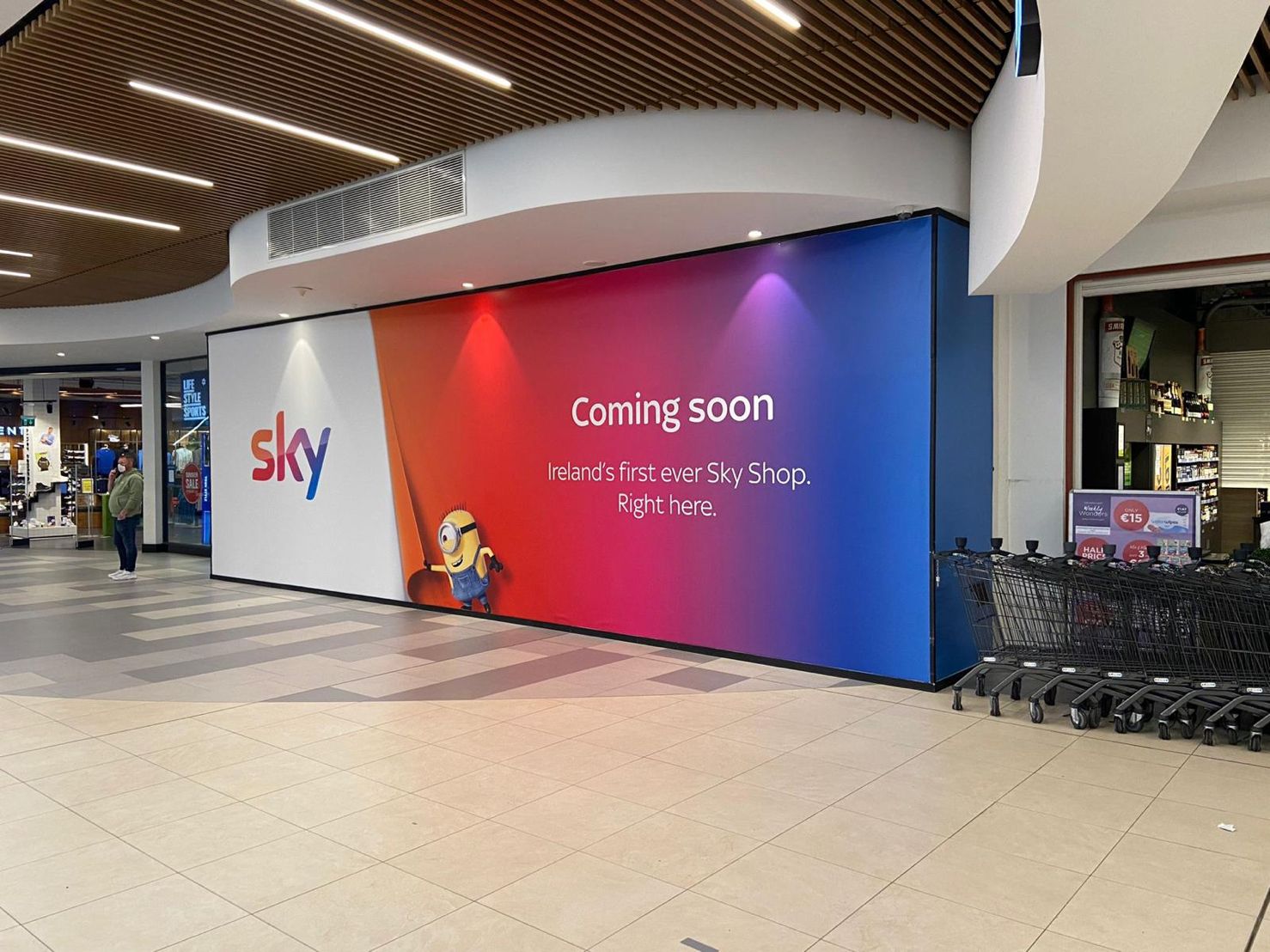
Another first for Blanchardstown Centre and part of a run of some exciting announcements for the scheme. Having the first Sky Store in Ireland will bring some interesting animation and events to the centre.
We are delighted to have advised Falcon AM and Blanchardstown Centre on this letting working with Eoin Feeney on the successful deal.
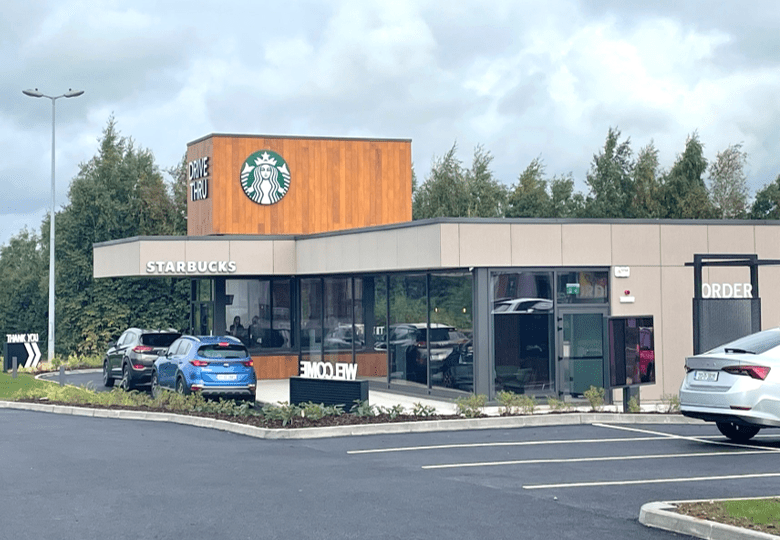
After a highly anticipated wait, coffee lovers in the Naas and surrounding areas finally get to see Starbucks open in Naas Retail Park. It is a state-of-the-art 2,500 sq. ft coffee pod with in-store seating as well as a customer collection drive-thru lane for customers who want to grab a coffee on the go. There are also three e-charging car park spaces located at the front of the store for the charging of electric vehicles.
Arguably the most famous coffee company in the world, Starbucks was founded in 1971 in Seattle and currently has more than 15,000 stores in over 50 countries. This will be Starbucks 105th store in Ireland and their third store in County Kildare.
The new opening of Starbucks is a wonderful addition to the strong line-up of retailers currently in Naas Retail Park. At present the retail park is home to Harvey Norman, B&Q, JYSK, Carpet Right, Choice, Currys PC World, Halfords and Right Price Tiles.
Paddy O’Connor from Sigma Retail Partners is the Asset Manager for Naas Retail Park, said “From the outset we have always seen the requirement for a coffee offering at the retail park, therefore we are more than delighted to have such a strong brand like Starbucks joining our tenants in the park. There has been a lot of excitement about Starbucks opening ever since construction begun and we are so pleased to finally see it materialise.”
Naas Retail Park is located off junction 10 of the N7 and is just ten minutes from Naas Town Centre. The retail park offers ample free customer car parking too. It also has a GoCargo van for hire on-site that can be booked by the hour or day via the GoCar app or website, to conveniently transport bulkier purchases home.
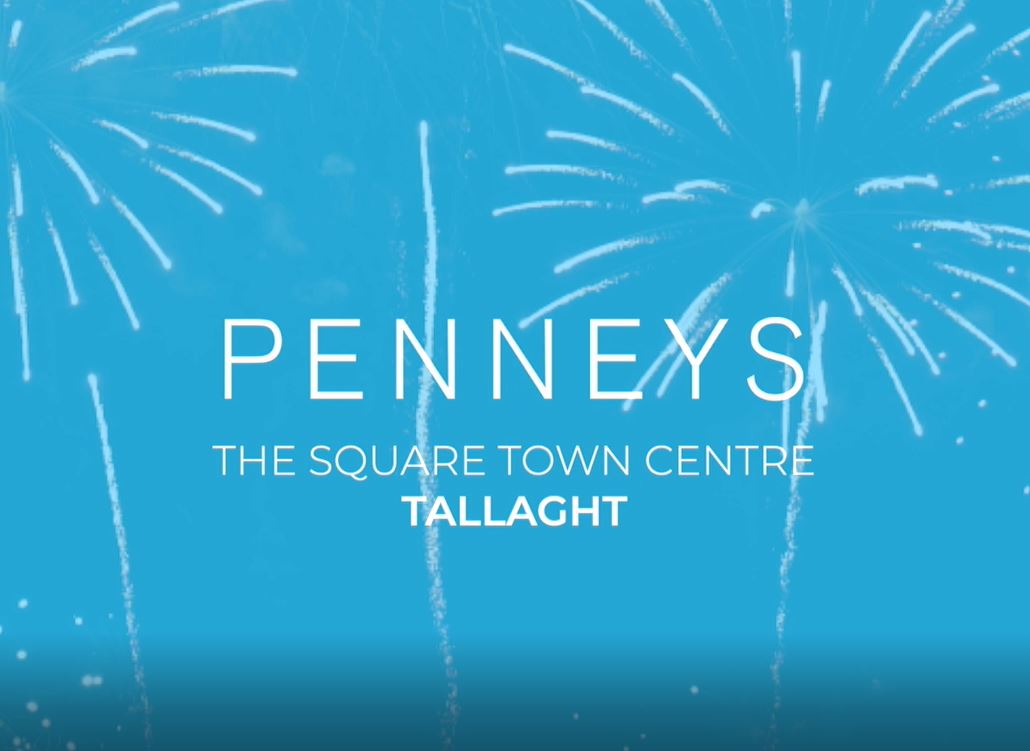
Penneys will bring its ‘Amazing Fashion at Amazing Prices’ to The Square Town Centre as the much-loved iconic Irish retailer announces that a new Penneys store will open at the centre, marking the continued expansion of the brand in Ireland. The new store will provide a huge boost to the local economy and create 300 new jobs for the community, with doors opening to customers next year.
The new store will be located on the ground floor of The Square Town Centre and will boast 43,000 sq ft of retail space which will feature Penneys’ famous affordable fashion favourites, including the latest seasonal trends along with everyday must-haves for everyone. The much-anticipated arrival of Penneys to The Square Town Centre will mark the retailer’s 37th store in Ireland; a significant milestone for the company that operates in over 395 locations across Europe and North America.
Damien O’Neill, Head of Sales, Penneys ROI, said; “We are really excited to confirm the opening of our new store in Tallaght next year. Penneys is iconic in Ireland; we have a strong presence in Dublin and across Ireland, and it’s really important to us when opening any new store, that we do so in the right location. We couldn’t wish for a better location for our next store in our home market than in The Square Town Centre. In the coming months, our teams will be working hard to bring Penneys’ unique in-store design and customer experience offering to life and we are looking forward to opening our doors to customers later next year.”
Jack Martin, Head of Retail for The Square Town Centre, said; “We are absolutely delighted with this announcement as it has been long overdue for Tallaght. Penneys is a fantastic retailer that will add a great offering to the Centre. For many years, the people of Tallaght have been very vocal in their desire to have Penneys in The Square and I have no doubt they will celebrate this news with us and make this opening a very successful and memorable one. This will bring jobs and prosperity to Tallaght and we are very excited to be partnering with such a great brand.”
Freda O’Donnell, The Square Town Centre’s asset manager from Sigma Retail Partners, said; “We are so pleased to announce that Penneys will be opening in The Square; a huge refit of the space is underway, and we are very excited with Penneys’ plans for their new store. Since we were appointed asset managers of the Square Town Centre in 2018, securing Penneys as a tenant has been a priority for Sigma Retail Partners and we are thrilled that they are joining our tenant line-up. They will no doubt be very successful, and we wish them all the best for now and the many years to come.”
Cushman and Wakefield and Bannon are joint letting agents for the owners of The Square while Penneys were advised by Savills.
The Square Town Centre was acquired by US private equity giant Oaktree Capital in 2018 and it is asset managed by Sigma Retail Partners. It currently has 160 retail units and more than 2,400 car spaces. The Square Town Centre consists of 577,500 sq. ft located on a site of 27 acres. Hugely popular with shoppers, the centre attracts footfall of over 15 million people each year.
Maxi Zoo will open their first ever store in Sligo on 9th September at Sligo Retail Park. Their new store is over 7,000 sq. ft and stocks an extensive range of pet products. This store is Maxi Zoo’s 21st store in Ireland and it will create 15 new jobs.
As one of Ireland’s largest pet retailer with 21 stores in the Republic of Ireland, Maxi Zoo opened its first store in Cor
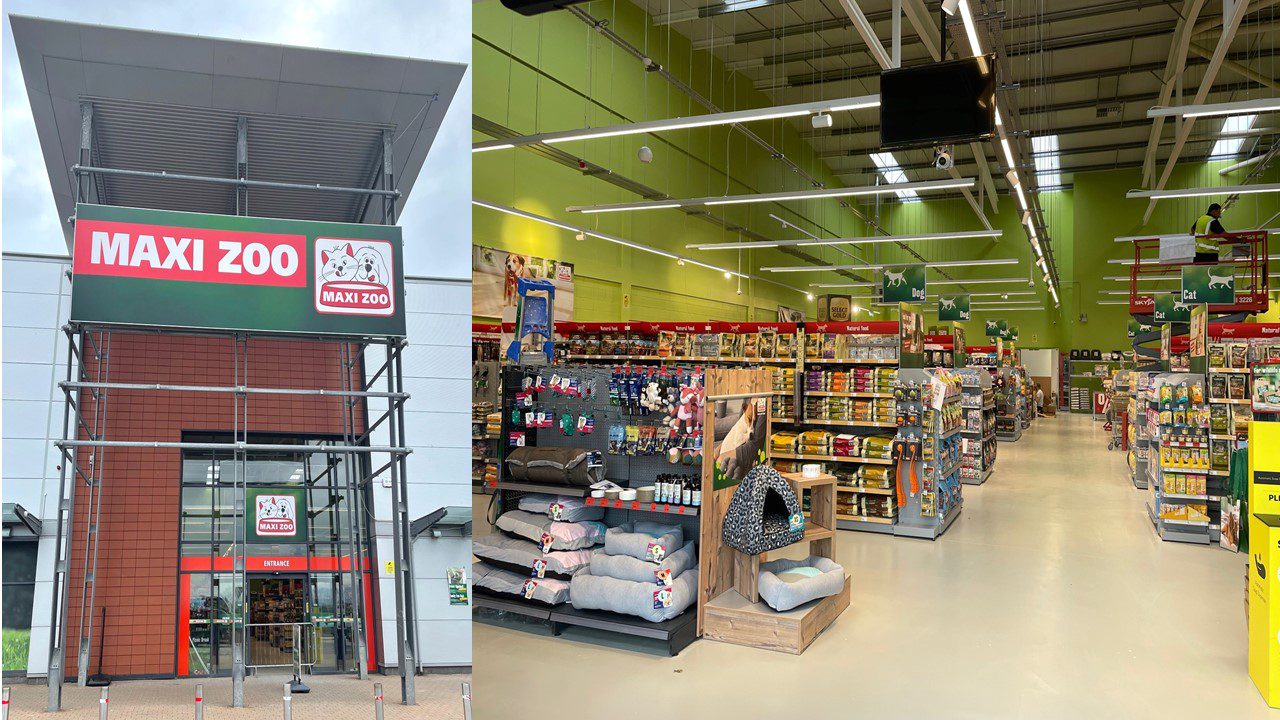
k in 2006 and currently employs over 170 staff. It is part of the Fressnapf Group with over 1,700 stores across Europe, with more than 8,000 products in their extensive range and offers personal consultations for pet owners.
Maxi Zoo is celebrating the opening of their new store with a ‘Spend and Save Incentive’ from 9th – 12th September, with fun and exciting in-store and outdoor activities including a photo booth, in-store DJ, balloon modeller, magician and hourly raffle prizes planned for Saturday 11th September.
“This is a really exciting new store opening for Maxi Zoo as our first step to realising our ambition to extend our offering, first-class customer service and vast product range to pet owners in the West of Ireland,” said Enrico De Luca, Country Manager for Maxi Zoo Ireland. “This marks a new chapter for the business and signals our strategy for continued growth. Over the last 18 months, we have seen our business and sales boosted dramatically with more new pet owners and existing pet owners having a greater desire and disposable income to treat their pets. It’s been wonderful to see the bond that owners have with their pets become even stronger throughout the challenges and uncertainty we’ve faced. Choosing the dynamic region of Sligo in the heart of the North West was a natural first choice of location. Our new store in Sligo will be closely followed with another large store opening in the South West with further plans for expanding Maxi Zoo’s retail network over the coming 12 months.”
Maxi Zoo Sligo store manager Rory Farrell added: “We are so excited to open the doors and to welcome pet owners and their pets in our store. We are always on hand to offer advice on food, as well as coat and harness fitting and a free weight check for your dog. We really do have everything a pet parent might need – after all, happier pets, happier people.”
Paddy O’Connor from Sigma Retail Partners is the Asset Manager for Sligo Retail Park. He said “Maxi Zoo is a very well-known and strong brand in Ireland and Europe and we are delighted that they have chosen Sligo Retail Park as their first store location in Sligo. Their new store’s fit-out looks fantastic and we are confident that pet owners and animal lovers will enjoy their presence immensely. We look forward to them performing very well in the retail park.”
Sligo Retail Park is the primary retail park destination in the North West catchment area with stores catering to a wide variety of customers and accommodates diverse retail use. It has a total of 14 retailers that include JYSK, Currys PC World, Smyths Toys, Homebase, Castle Davitt, Right Price Tiles, Pet Stop Discount, Homestore & More, EZ Living, McDonalds, Costa and KFC, with 1,000 free car parking spaces.

Krispy Kreme has chosen Swords Pavilions shopping centre in North County Dublin for the site of its second store in Ireland.
The new Swords shop is due to open this winter and will be located in the former KFC unit, beside Elverys Sports and Penneys in the shopping centre.
Krispy Kreme opened its first store in Ireland – in Dublin’s Blanachardstown – in 2018.
Hammerson and Irish Life are joint owners of the Swords Pavilions shopping centre.
With over 100 retail, dining and entertainment brands at Swords Pavilions, Krispy Kreme joins The Gift Shed, a new pop-up concept by the Kilkenny Group, fashion brand Catch and music store Golden Discs as recent openings in the shopping centre.
Ciara Connolly, Head of Leasing, Ireland at Hammerson, said it was a real vote of confidence in Swords Pavilions that a household name such as Krispy Kreme has chosen to join the centre in the early stages of its Irish expansion.
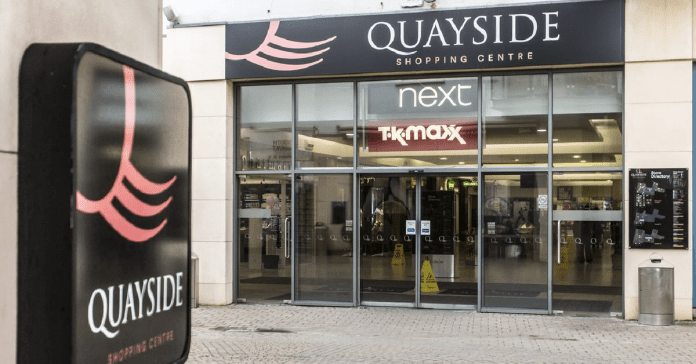
Retail is back and it’s here to stay, says Christine Dolan of Quayside Shopping centre in Sligo Town.
The centre manager believes that the majority of Irish consumers prefer the social experience of a trip to the shops over the convenience of e-tail.
She told the All-Ireland Business Times that Quayside is busier than ever.
“I think people have missed coming into the shops”, she said. “It’s a totally different experience to shopping online.”
“People love the social aspect of a day out shopping and I think most people are sick of the virtual experiences – there are a lot of people who have been quite lonely through the pandemic and you can’t beat meeting up with friends for a lunch date while having a browse through the shops.”
“There’s a great buzz around at the moment and people are starting to mix again and enjoy themselves.”
A 2020 report by Deloitte found that retail is Ireland’s largest industry and the largest private sector employer, employing almost 300,000 workers – with three in four of those employed based outside of Dublin.
Quayside Shopping Centre opened its doors in 2005 as the largest shopping centre in the northwest of Ireland.
With 130,000 feet of floor space the centre boasts 43 retailers including TK Maxx, Lifestyle Sports and Next.
Quayside lost two retailers over the pandemic, one of them was a Carphone Warehouse store which was a casualty of the Group’s decision to close 80 stores in Ireland last year.
Christine revealed that units have since been filled by two new tenants with more set to come on board.
While Christine admits that competing against online retailers will be a tough challenge in the years to come, she is not worried about the long term future of her industry.
“What we’ve proven here time and time again is that we are resilient.”
“We’ve been through a recession and we’ve come out stronger on the other end so I have no doubt that we will get back to where we were pre-pandemic.”
“In fact, I think we’ll be in a better place.”
According to the Central Statistics Office’s Retail Sales Index retail sales increased by 3.3% in June this year compared to May on a seasonally adjusted basis. On an annual basis, retail volumes were 10.6 per cent higher than in June last year.
Interestingly the retail sales figure for June this year was 13.4% higher when compared to two years earlier, before the Covid-19 pandemic.
Quayside Shopping Centre recently landed its third Business All-Star Accreditation in recognition of its contribution to retail in Ireland.
Reacting to the news, Christine said: “I am delighted to be part of an ambitious All-Star Business. To be accredited for the third year in a row is a huge honour and I see it as recognition of the hard work that goes on behind the scenes.”
Quayside’s focus over the next few months is to promote the “shopping centre experience” and Christine revealed that the centre will be introducing an initiative to help local craftspeople and creators.
She said: “We have plans to relaunch our very successful Christmas markets and hope to do this a little bit early this year. The markets provide a wonderful opportunity for local traders who may have been out of work the last while and want the chance to set up a pop up shop or trading stall.”
“We really want to celebrate with our customers and give something back to the local community this year.”
To learn more about Quayside Shopping Centre Sligo, visit their All-Star showcase page here.
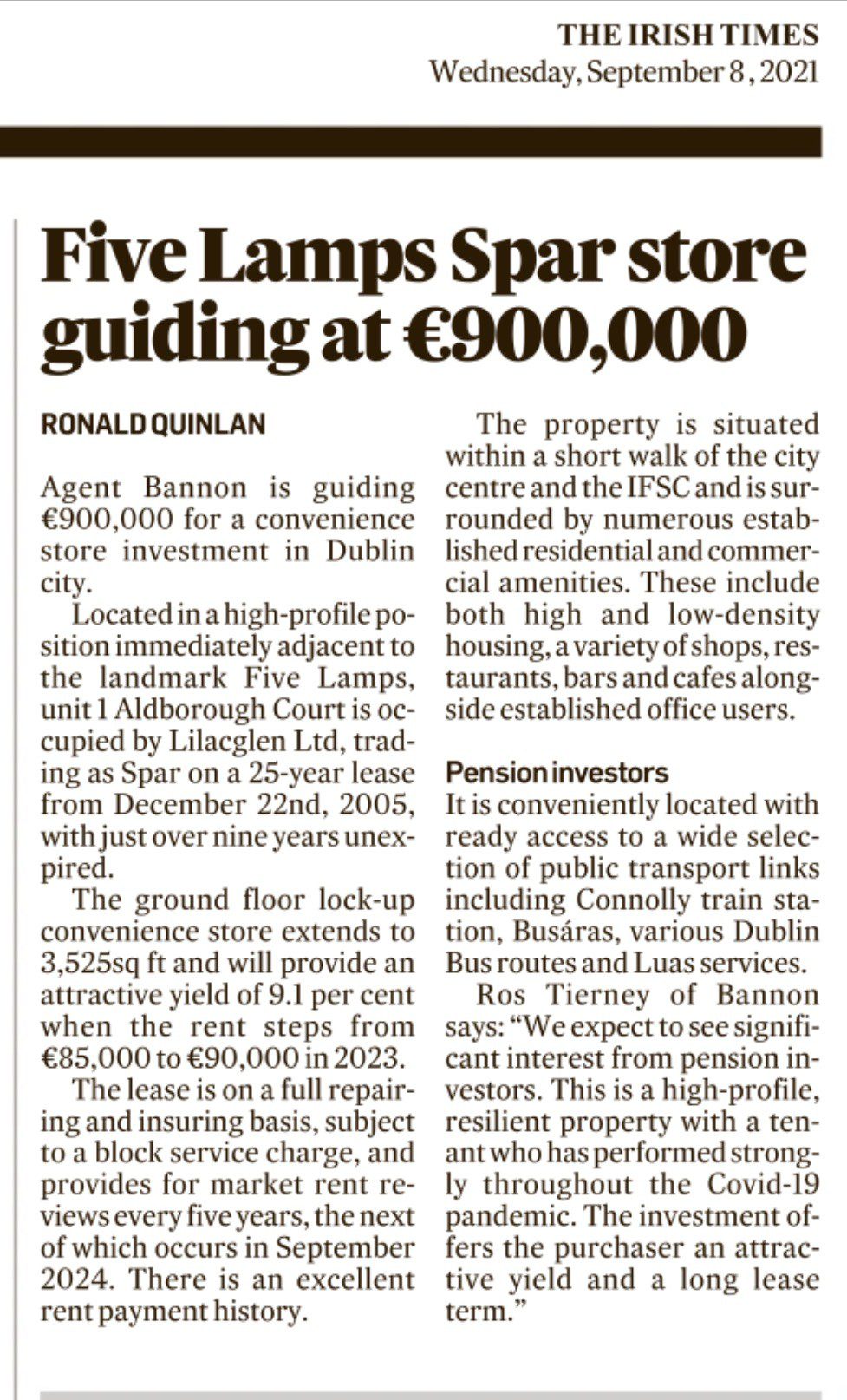
Five Lamps Spar store guiding at €900,000.
Ros Tierney of Bannon says: “We expect to see significant interest from pension investors. This is a high-profile, resilient property with a tenant who has performed strongly throughout the Covid-19 pandemic. The investment offers the purchaser an attractive yield and a long lease term.”

In a wide- ranging feature for “My Job” in the business section of today’s @IrishExaminer, our founder and executive chairman @NeilBannon talks about the the importance of sustainability and what it means in practical terms, how clients are seeking to leverage the firm’s market leading expertise in Retail and apply it to a new user experience for the office.
He believes that there is a need for a big reset in how we imagine the office, moving it from being merely a functional space with a desk to a new proposition where it is an experience-led, productive, enjoyable place to create, collaborate and engage with colleagues.
Neil also talks about prospects for Cork and its hinterland plus how – as Ireland’s largest domestically owned Commercial Property Consultancy in a market dominated by global brands – our firm not only succeeds, it thrives.
Thanks to John Daly at The Irish Examiner for the opportunity.
Take a look at the link below:
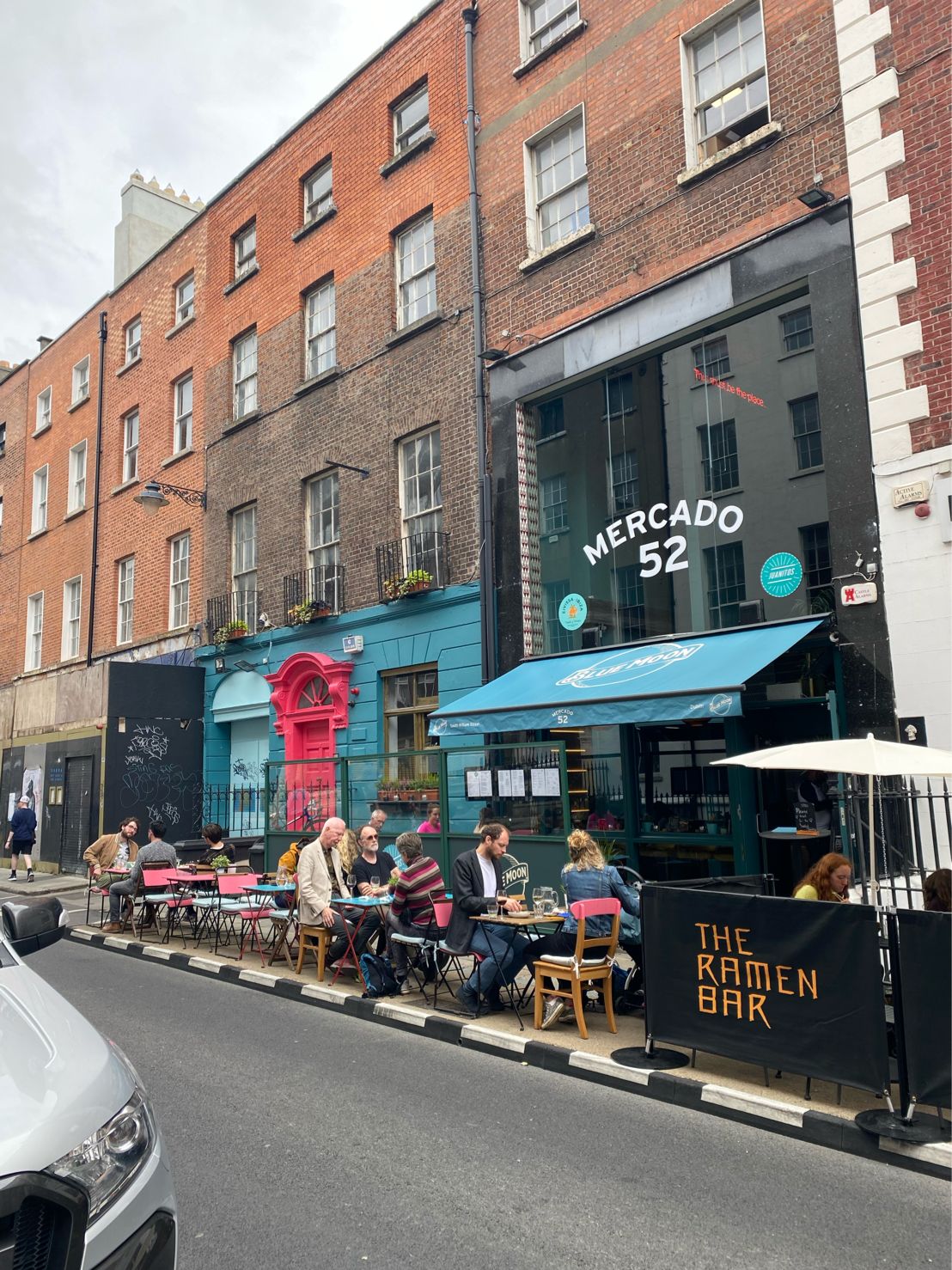
Another fantastic addition to South William St with Mercado 52 opening it’s doors to the public in the past few weeks. This unique multi-concept bar and restaurant is an exciting new venue for Dublin City from the team behind Juanito’s on Drury St. It was a pleasure to work with Cian Hamill and Aviva on this letting and we look forward to working with the guys again in the near future.
Give Bannon a call on 01-6477900 to discuss other similar properties currently available or if you have a property you might be interested in bringing to the market.
 We were delighted to hear our Executive Chairman Neil Bannon interviewed on Executive Chair, part of Newstalk’s “Down to Business” radio show on Saturday. Neil and Bobby discussed the big changes to the nature of the Office and how it will move from being functional to experiential. He provided the valuable insight that Investors and Employers are now going to be more concerned about the experience of being in the office. It will no longer simply be a place with a desk but instead somewhere you look forward to visiting in the new hybrid working world.
We were delighted to hear our Executive Chairman Neil Bannon interviewed on Executive Chair, part of Newstalk’s “Down to Business” radio show on Saturday. Neil and Bobby discussed the big changes to the nature of the Office and how it will move from being functional to experiential. He provided the valuable insight that Investors and Employers are now going to be more concerned about the experience of being in the office. It will no longer simply be a place with a desk but instead somewhere you look forward to visiting in the new hybrid working world.
As a result, he mentioned that Bannon had seen a notable increase in clients seeking to have the firm leverage our market leading Retails skills and apply them to the Office. Other topics covered included how Neil’s Law degree helps with complex lease and purchase negotiations, setting up Bannon with his father Joe and how an independent, Irish owned business, excels at competing with multi-national competitors in this market.
Take a listen…..

In Irish history, there have been numerous examples of the presiding Government instigating a Compulsory Purchase Order (CPO) to implement national projects. Intentions being for the future development of the country and public interest. A Government Minister or Acquiring Authority is required to seek a CPO from An Bord Pleanála and in contentious cases such an order can be expedited to provide a clear pathway and certainty around the delivery of a project of national importance.
The rules for the assessment of compensation for land taken on foot of a compulsory acquisition, generally provide that the value of land shall be taken to be the amount, which the land if sold in the open market by a willing seller, might be expected to realise. Compensation will also deal with issues such as severance and disturbance to remaining landholdings. The characteristics and attributes of the property are considered as part of any assessment of compensation payable to the landowner. If zoning is in place for residential development for example, the potential of that development and the requirement for much needed housing will be reflected in the compensation payable.
But CPOs are not just about money. The decisions and process involved can be emotive. There are many stakeholders to consider and objectives to be met. In some cases there is merit in considering a CPO for the successful delivery of projects of importance. However, for every project that needs to be realised, there are landowners who need to be accommodated. Many have a long history with their property, and they hold sentimental attachment in addition to financial value to them. It is never a simple choice to sell that asset or be forced to sell it.
Depending on the project, such compensation sums for land acquisition may be considered relatively modest given the overall cost of the project. However the personal cost to landowners may be significant as they can be dealing with the compulsory acquisition process for years before reaching a conclusion.
Acquiring authorities must carefully navigate the legal process, taking the obligatory steps with fairness and consideration. Landowners must equip themselves with the knowledge and understanding of the process and the impact on their livelihood. Specialist advice is essential on both sides to understand the true value of the property, both as a single property and as part of a wider scheme.
Our small island will continue on its path of growth and development. Our challenge is to balance how we use the land we have for the good of our people, both users and owners.
Niall Brereton BSc MRCIS MSCI is a Registered Valuer and experienced Compulsory Acquisition Practitioner with Bannon Chartered Surveyors and Property Consultants. Niall has advised on multiple CPOs, acting primarily for individual claimants and corporate landowners.
Bannon is currently advising landowners in respect of the following CPO projects:
https://www.corkrdo.ie/major-schemes/m28-cork-to-ringaskiddy-project/
https://www.foyneslimerick.ie/
 Covid-19 and Sustainability awareness are changing Ireland’s commercial property market
Covid-19 and Sustainability awareness are changing Ireland’s commercial property market
By Neil Bannon, Executive Chairman, Bannon
Opinion piece published in the Property Plus supplement, The Business Post, Sunday, July 25, 2021
The Commercial Property market will look very different in the coming years due to two game-changers – Covid and its permanent impact on the World of Work and the little-known but the highly important Environmental, Social and Governance (ESG) system that is the benchmark for assessing the environmental impact of real estate.
The Future of the Office – What’s Next?
The reality is that Covid has changed the world of work for both employers and employees. The office of Now and the Future needs to be accommodated in more sustainable, user friendly buildings, where wellbeing for its users is prioritised and consideration is given to how occupiers and users interact with and experience the building – both internally and externally. Also, we believe that, where possible, buildings should feel like an integral part of local communities and neighbourhoods and not appear “stand alone.”
In the past six months especially, we have noticed a spike in demand from clients who are talking to us about taking our market leading expertise in retail from such buildings as Dundrum Town Centre, Pavilions S.C. and The Square, Tallaght and applying those insights into new work environments. Unlike many players in the Irish market who are international, Bannon is a local business with deep roots here. We understand the “real world” 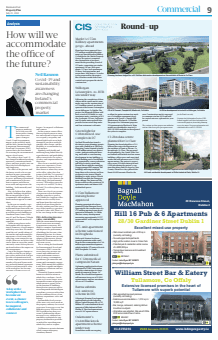 culture of the market and understand the importance of real estate delivering long term returns for our clients. However, we believe this can be done in a way that simultaneously creates better places to work and reduces the impact on the environment.
culture of the market and understand the importance of real estate delivering long term returns for our clients. However, we believe this can be done in a way that simultaneously creates better places to work and reduces the impact on the environment.
One of the biggest changes to the office is that it is no longer just a place with a desk but has become a destination in itself. To many employees now used to months of focused home working and with limited opportunities for social interaction, a day at the workplace has become an event, a chance to see colleagues, be inspired, collaborate and connect. In this context, smart offices that use digital sensors to monitor and respond to factors such as occupancy, air quality, natural light levels are in high demand as are those with sustainable office design, and the flexibility to accommodate Hybrid workers.
Last, but certainly not least, with health and wellbeing being linked directly to productivity and profitability, offices now need to be a place of safety and empowerment for users.
More focus is needed on the entire user experience. From the moment when someone leaves their house, to arriving at their office, what does that entire journey look like? Is it positive? Do they know where the local barber shop is; the chemist; the coffee shop, the fundamental services? When they enter the car park, is it well lit? Do they feel safe? Does their phone signal work? There are a lot of very personal experiences that impact whether your day is good or bad and I think that the corporate office market needs to really focus and learn from the retail sector which has been doing this for decades, in terms of making sure that every step of the journey is a positive step and a value add. That’s something we can change a lot in terms of the office.
ESG – delivering investor value, sustainably
With the environmental impact of real estate now increasingly important to investors, the ability to monitor, benchmark and improve the performance of buildings has become a fundamental objective for its clients. In Ireland, Bannon was an early adapter of the Investor-driven Global ESG Benchmark for the Real Estate Sector.
This is setting the benchmark for Environmental, Social, Governance (ESG) across the sector. Investors are now concerned with additional real estate performance metrics, such as energy consumption, greenhouse gas emissions and tenant and community engagement. With annual data updates, it will have a significant impact on property valuations and sustainability.
Ultimately, Bannon matches businesses with locations from which they can thrive. Our objective is to create longer term sustainable returns in property which means a greater focus on the function of buildings through active property and asset management and intelligent consultancy services rather than just the traditional focus of our industry Acquisitions, Sales and Lettings.
Sustainability has been one of the most over-used words in the property industry for several years now. It was easy to say but difficult to prove. What recent ESG legislation has done is create the platform that allows investors to see validated sustainability credentials for any property within their portfolio or indeed for something new which they wish to acquire.
Article by The Sunday Business Post
Thurles Shopping Centre has just opened a new store The Gourmet Butcher in the last two weeks. This is their second store with the first one in Clonmel, Tipperary. The new store has a lovely, modern-looking fitout. The Gourmet Butcher are speciality Artisan butchers who are locally-owned and independently run, supplying the highest quality locally sourced meat and dry aged beef.
The owner Kevin Walsh, a Tipperary businessman, decided to expand his operations despite the uncertainty caused by the ongoing pandemic and up to eight jobs have been created in the newly opened store. He said “Thurles Shopping Centre is a location we have been looking at on and off for the last two years. Our business model is a proven model and we won Best Retailer in Tipperary with the Chamber Business Awards two years ago. We think we’ll be a really good fit for the centre – there’s a massive grocery footfall there. We just think that our set-up, which is a traditional butcher with a modern twist, will go really well in that area.”
Sigma Retail Partners, the asset management company for Thurles Shopping Centre, acquired the centre in July 2015 and has put in place an active asset management plan since its acquisition. Emma Leonard from Sigma Retail Partners is the asset manager for Thurles Shopping Centre. She said “We warmly welcome The Gourmet Butcher to the shopping centre and believe they will bring a fresh offer to the centre’s customers. The Gourmet Butcher has received an overwhelming response in their first few weeks of trading and we are confident that they will do very well in the centre. I wish them all the best in their new store.”
Thurles Shopping Centre is walking distance from Thurles Town Centre and has a floor area of 110,000 sq ft. It has a footfall of approximately 55,000 per week and houses 600 car park spaces. Anchored by Dunnes Stores, it has 28 units in total with retailers including Boots, Vodafone, Holland & Barrett and Carraig Donn.
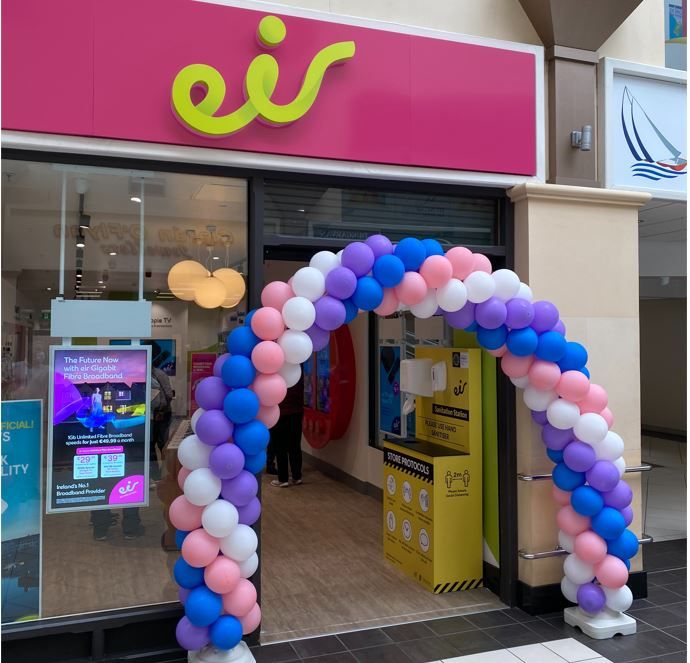
Dungarvan Shopping Centre is excited to announce that it has just added Eir to its established list of retail stores.
This latest store in Dungarvan Shopping Centre has further increased the wide variety of shops already trading in the shopping centre. The brand Eir is very well-known in Ireland and it is one of the principal providers of fixed-line and mobile telecommunications services, serving approximately two million customers. The Eir group provides a comprehensive range of advanced voice, data, broadband and TV services to the residential, small business, enterprise and government markets.
Paddy O’Connor from Sigma Retail Partners is the Asset Manager for Dungarvan Shopping Centre. He said “We are fortunate that one of the leading brands of telecommunications services in Ireland has opened a new store in Dungarvan Shopping Centre. We have always believed in the importance of offering a wide range of retailers in all our shopping centres, for our customers and the local community, and the new Eir store complements very well to the tenant mix. Their new fit-out looks great and we wish them the best of luck in the centre.”
Anchored by Dunnes Stores, Dungarvan Shopping Centre has a total of 34 retailers including Eason, Carraig Donn, Game Stop and Lloyds Pharmacy. Dungarvan Shopping Centre is located in the centre of Dungarvan town centre and has a large multi-storey car park available to its customers.
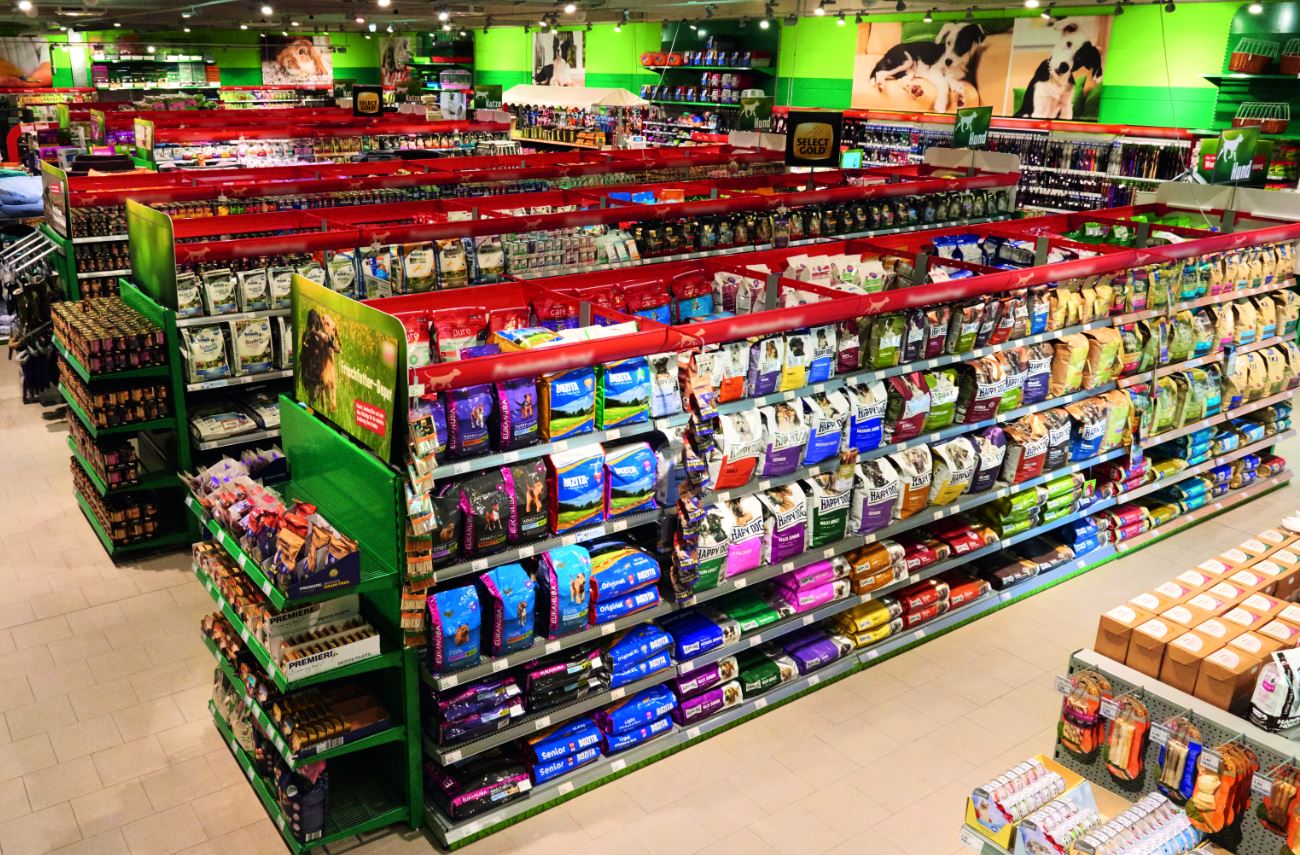
Maxi Zoo has confirmed that it will open a new store in Sligo Retail Park in September this year. Fit-out works have already begun, and this will be their first store in Sligo.
The store will be over 7,000 sq. ft and much to the delight of pet lovers in the local community and the surrounding catchment areas, it will stock their extensive range of pet products.
Maxi Zoo is Ireland’s largest pet retailer with 20 stores in the Republic of Ireland, and opened its first store in Ballincollig, Cork in 2006 and the company currently employs over 170 staff. It supports numerous local animal welfare charities and is Ireland’s largest pet retailer and part of the Fressnapf Group, with over 1,650 stores across Europe with more than 8,000 products in their range.
Paddy O’Connor, Asset Manager from Sigma Retail Partners, said “Maxi Zoo is a very strong brand in Ireland and Europe and we are delighted that they will be joining the tenant line-up in Sligo Retail Park. Maxi Zoo also has stores in two of our retail parks that we manage, Naas and Waterford Retail Parks, and their business continues to perform strongly despite the current challenging times. We are confident they will continue their success in the new Sligo store and warmly welcome them into the retail park and wish them all the best.”
Darren Spoonley from Maxi Zoo said “Maxi Zoo Ireland are looking forward to opening our first store in Sligo as part of our ongoing expansion plan, bringing our store network to 21. We are excited to bring our huge range of pet products to new customers. Our highly trained teams will be on hand to advise on all your pet needs and highlight our fantastic prices and offers.”
Sligo Retail Park is the primary retail park destination in the North West catchment area with stores catering to a wide variety of customers and accommodates diverse retail use. It has a total of 14 retailers that include JYSK, Currys PC World, Smyths Toys, Homebase, Castle Davitt, Right Price Tiles, Pet Stop Discount, Homestore & More, EZ Living, McDonalds, Costa and KFC, with 1,000 free car parking spaces.
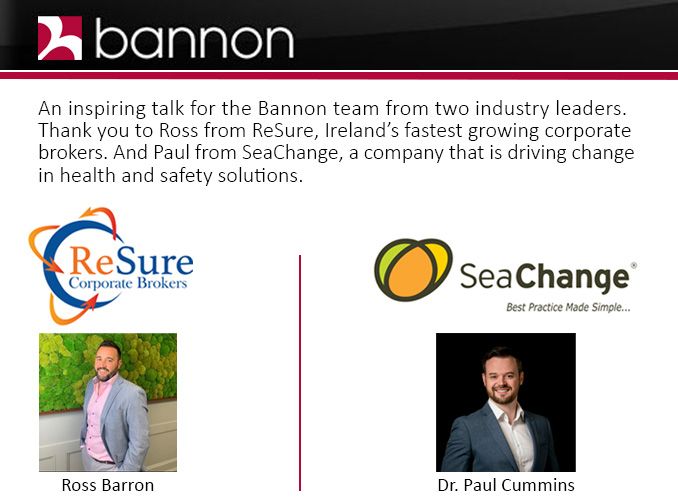
Bannon would like to extend a big thank you to Ross Barron (Director – Resure Corporate Brokers) and Dr. Paul Cummins (Managing Director – SeaChange) for their recent presentation on Liability Insurance / Health & Safety. It was also great to see such a strong attendance from the on site teams across our portfolio. We all gained some very valuable insights on subjects which play a huge part in our industry.
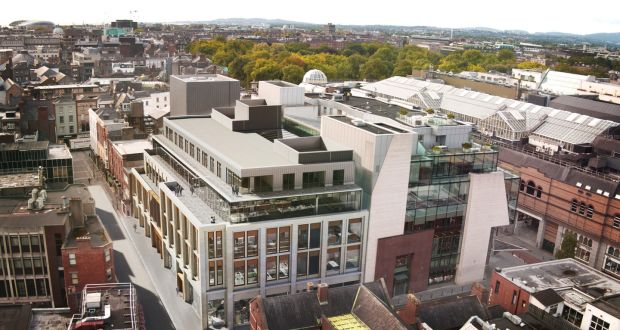
International real estate firm Hines has formally acquired the second phase of Chatham & King, a new high-profile mixed-use scheme next to the Gaiety Theatre on South King Street in Dublin city centre.
Hines’s acquisition of the 3,950sq m (42,500sq ft) portfolio marks the culmination of the €165 million deal it agreed with US private equity giant Lone Star for the wider Chatham & King development in 2018. In acquiring the scheme, Hines fended off three rival bids. Two of the competing offers came from German funds, while the third bid came from the billionaire founder of the Zara fashion chain, Amancio Ortega.
In securing ownership of the development, Hines gained immediate control of a mixed-use building with retail units comprising 3,112sq m (33,500sq ft) occupied by Zara, H&M and Warehouse, along with 2,879sq m (31,000sq ft) of overhead office space occupied by data analytics management firm Qualtrics as its European headquarters.
The second phase, which has now been completed by Lone Star, comprises six residential units, five retail units totalling 1,486sq m (16,000sq ft) and 2,461sq m (26,500sq ft) of office space which will be occupied by Qualtrics. The €40 million cost of developing the new building on Chatham Street and Clarendon Row was included as part of the €165 million deal agreed on behalf of Hines European Core Fund (HECF) in 2018.
Hines says that negotiations are at an advanced stage on each of the five new retail units, which range in size from 46sq m (495sq ft) to 1,178sq m (12,680sq ft). The incoming tenants will sit alongside the existing tenants, which include Zara, H&M and Apple-reseller CompuB, which recently signed a new lease for a 315sq m (3,400sq ft) retail unit on South King Street.
The Chatham & King scheme has a prime location next to Grafton Street and St Stephen’s Green, and sits within close proximity to the Westbury Hotel and the new Dublin headquarters of the European Parliament, which is scheduled for completion in November 2023.
Simone Pozzato, managing director and deputy HECF fund manager at Hines, said: “The acquisition of phase two of Chatham & King completes the final element of this portfolio and marks the delivery of an LEED-accredited asset in the Dublin office and retail sector at an opportune time. The property is an excellent fit for HECF given its central location in Dublin, a city which continues to show strong economic growth.
“We are already encouraged by the promising engagements to date from some very exciting retail brands who would be ideally suited to this prestigious shopping district. We hope to have further announcements in this regard in the near future.”
Peter Lynn, director with Hines Ireland, added: “We are delighted to make this timely announcement as Dublin city centre continues to reopen and as Chatham Street itself has recently undergone a significant transformation with Dublin City Council’s pedestrianisation programme. Chatham & King is a high-quality addition to this historic street and our new retail spaces will represent a significant enhancement to the city’s most fashionable shopping district. We are also equally excited to be working with Qualtrics as our lead office occupier as they continue on their growth story.”
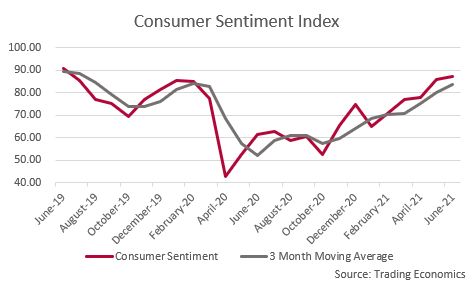
Irish consumer sentiment is at a two-year high following a modest 1.6% monthly increase in June. This increase brings the index back in line with the 25-year average of the series suggesting sentiment has been normalised. This is further supported by the fact that June marks the fifth successive monthly increase in the index, the first time that has happened since the beginning of 2007. These results suggest that Irish consumers are becoming less concerned about their current circumstances and less fearful about the future which bodes very well the retail sector. Furthermore, trends over the past decade show consumer sentiment as a very accurate leading indicator of retail sales.
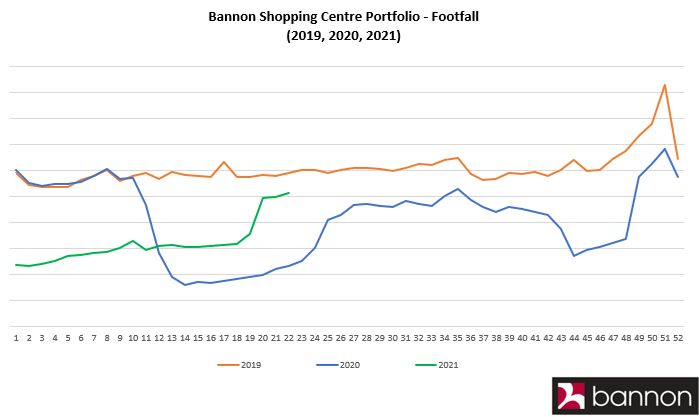
There is an air of positivity coming from our shopping centre & retail park management teams across the country. It has been great to see the rebound in footfall since full reopening of our portfolio on the 17th of May last. The first three weeks since reopening have seen weekly footfall jump back to 86% of the levels seen in 2019. What’s much more significant is the number of retailers reporting May 2021 sales information (a total of 14 days) being ahead of May 2019 (31 days). There is no question that retailers need to see a sustained period of brisk trade but the data so far is pointing in the right direction.
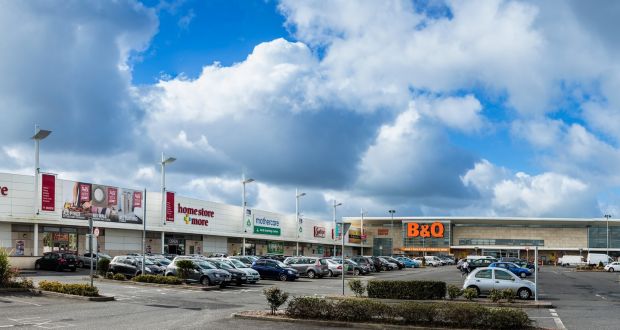
With online shopping having come into its own following the unwelcome arrival of Covid-19, the sale by New York-headquartered Marathon Asset Management of three of Ireland’s best-known retail parks is set to test the post-pandemic appetite of investors for traditional bricks-and-mortar retail.
The Parks Collection is being offered to the market individually or as one lot by joint agents Cushman & Wakefield and Savills at a guide price of €78 million. The portfolio comprises Belgard Retail Park in Tallaght, Dublin 24, the M1 Retail Park in Drogheda, Co Louth, and Poppyfield Retail Park in Clonmel, Co Tipperary.
While the sale of the entire offers the prospective purchaser the opportunity to secure a collection of strongly-performing retail parks and an attractive net initial yield of 8.43 per cent, the portfolio’s assets are expected to see interest on an individual basis also.
Belgard Retail Park, for its part, is regarded as one of the foremost retail parks in the capital. Located on the Belgard Road in Tallaght and 11km from Dublin city centre, the scheme comes for sale fully-occupied and anchored by B&Q, the largest home improvement and garden centre retailer in the UK and Ireland. Other occupiers include Homestore & More, Dealz, Carpet Right, Halfords, Right Style Furniture, Burger King and Starbucks.
While the scheme currently extends to 12,728sq m (137,000sq ft) with 482 car parking spaces, it has planning permission for an additional retail warehouse unit of 2,404sq m (25,877 sq ft) over two levels with 1,409 sq m (15,166 sq ft) of ground-floor space and 995sq m (10,710sq ft) of retail warehouse/storage space at mezzanine level.
The total current rent is about €3.13 million per annum with a weighted average unexpired lease term of 7.3 years. B&Q contributes around 67 per cent of the income on a lease until 2028 with an upward-only rent review clause.
The M1 Retail Park is located 3km west of Drogheda town centre and just off the M1 motorway connecting Dublin and Belfast. It comprises a mix of retail, office and leisure accommodation extending to a total of 24,805sq m (267,000sq ft), along with 600 car-parking spaces. The majority of the development is taken up by retail and leisure (89 per cent) and is anchored by Woodie’s DIY who occupy 4,885sq m (52,585sq ft). The park’s other tenants include Smyths Toys, Sports Direct /Brand Max, Dealz, Equipet and EZ Living amongst others.
The total current rent is €2.44 million per annum with a weighted average unexpired lease term of 8.4 years. Woodies (with lease guarantees from Grafton Group plc) contributes around 40 per cent of the income on a lease until September 2030 with upward-only rent reviews.
The scheme also includes Mellview House, a four-storey building comprising 25,048sq ft of office space, a 30,483sq ft gym at ground floor, basement and mezzanine levels operated by Gym Plus and a number of other smaller retail units. Another building known as the Pavilion is home to Costa Coffee and TC Matthews with a recent new letting to Lanu Medi Spa.
An additional site adjacent to M1 Retail Park also forms part of the Parks Collection sale. The land extends to 27 acres and comprises three adjoining plots with proposed zoning under the Draft Louth County Development Plan 2021-2027 for three uses, namely ‘A2 New Residential’, ‘ C1 Mixed Use’ and ‘ B4 District Centre’.
99% occupied
Poppyfield Retail Park is located 2.5km from Clonmel town centre at the junction of the Cahir Road and the N24. Developed in 2004, the scheme extends to 12,821sq m (138,000sq ft) and comprises a mix of 14 retail warehousing units, a neighbourhood centre and 393 car-parking spaces. The park is 99 per cent occupied and anchored by Woodie’s DIY (with a lease guarantee from Grafton Group plc) and SuperValu. Other high-profile tenants include Harry Corry, Maxi Zoo, EZ Living, World of Wonder and DID Electrical. The neighbourhood centre is occupied by Costa Coffee, Sam McCauley, along with a hair and beauty studio and fish-and-chips operator. KFC also have a drive-through at the entrance to the park which does not form part of the sale.
The total current rental income is €1.43 million per annum and the weighted average unexpired lease term is seven years. Woodie’s and SuperValu contribute around 52 per cent of the income, and have seven and eight years remaining on their respective leases.
Marathon Asset Management acquired the M1 and Poppyfield parks originally as part of a larger portfolio in 2014, which also included The Park, Carrickmines; Lakepoint Retail Park, Mullingar; and the Four Lakes Retail Park in Carlow. Belgard Retail Park was acquired separately.
Marathon has undertaken significant asset management and phased disposal of these assets since then. The latest sale from its Irish retail portfolio was completed only this week and saw a private high net worth investor paying close to €7 million to secure ownership of Lakepoint Retail Park in Mullingar.
The scheme, which is anchored by Woodie’s DIY, is generating total rent of €516,000 per annum giving the purchaser an initial return of just under 7 per cent. The deal was brokered on Marathon’s behalf by Rod Nowlan of Bannon while Declan Bagnall of Bagnall Doyle McMahon represented the purchaser.

We are very grateful for all the support we have received for our upcoming golf event in Carton House in aid of North Westmeath Hospice. The event has been sponsored by Joule and we have 28 teams golfing on the day. All in all a great result for the WDBN and our charity partner. All we need now is for the weather to play ball!
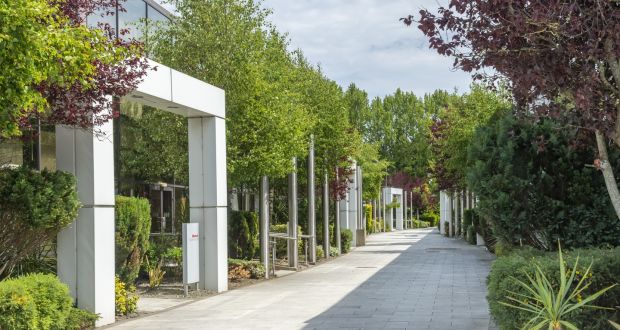
Doosan Bobcat, the US engineering and construction machinery manufacturer, has committed to a new 10-year lease on premises at Swords Business Campus in north Dublin.
It is understood that the US company has agreed to pay about €16 per sq ft for 10,000sq ft of office space at the development – a fraction of the €50 plus per sq ft it would pay in Dublin’s central business district.
While Doosan Bobcat had been based in the Swords business park already, it exercised the break option on its previous offices and had been looking for new space in north Dublin. Having explored a number of options in the area, the company decided to relocate to a new building at Swords Business Campus.
“Our business recently decided to remain at the business campus for the next number of years as we appreciate its cost competitiveness, its location and most importantly, our employees are very happy working here,” said David Guerra, human resources governance director for EMEA Doosan Bobcat. “With our employees commuting from Meath, Louth and the greater Dublin area, the location of the Swords business campus is ideal for our business.”
Conor Fitzpatrick of JLL’s office division, which is handling the lettings for the business park along with TWM, said availability within the campus has “steadily decreased” over the last couple of years.
“The owners have carried out significant works throughout the park, which has seen the improvement of both the standard of office space and the flexibility of offering for prospective tenants,” he said.
Both JLL and TWM say they are seeing strong interest for the remainder of the space within the park, with an emphasis among prospective occupiers for “ready-to-go” space which is capable of being adapted to bespoke requirements.
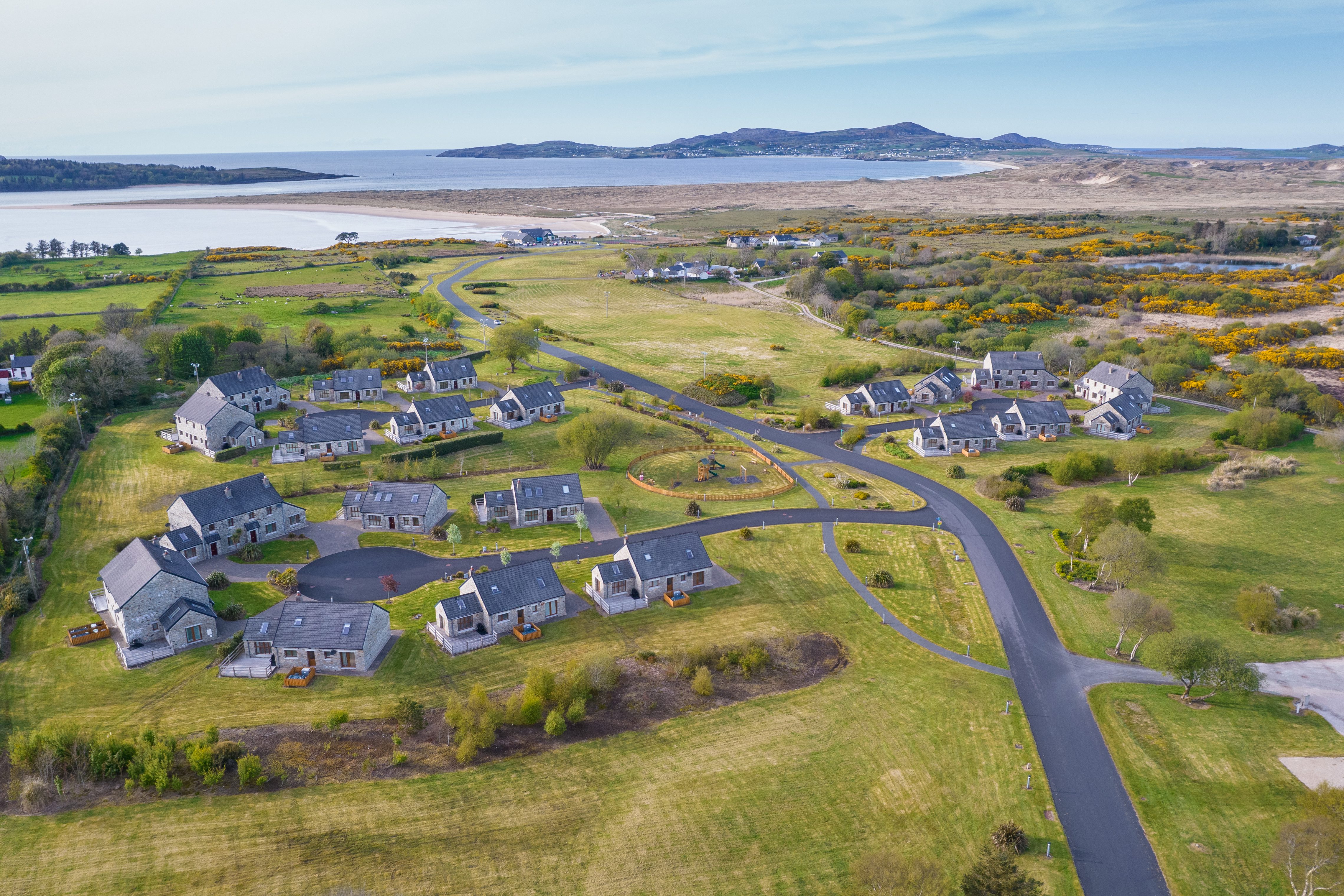
Developer Richard Barrett will be hoping the reopening of the country and the much-anticipated return to growth of the tourism sector will help to drive the sale by his company, Bartra, of the Donegal Boardwalk Resort.
Situated overlooking Sheephaven Bay and at the heart of Ireland’s Wild Atlantic Way, the complex is being offered to the market by agent Bannon with the tourism expertise of Niamh Walsh from TDL Horizons at a guide price of €3.8 million.
The Donegal Boardwalk Resort is a successful trading asset comprising 27 holiday villas arranged across three cul-de-sacs. All 27 units have all been recently upgraded by Bartra and are in turn-key condition, fully fitted and presented to a very high standard. Each villa benefits from a private deck/patio.
The resort also includes a fully-licensed seafront bar, restaurant and function room. The subject property comes with a total of 45 acres, much of which is still undeveloped.
The resort adjoins the spectacular 1km-long boardwalk which links it to Tramore Beach. The renowned four-star Rosapenna Hotel & Golf Resort is a neighbouring property.
The development is located within a short distance of the popular north Donegal tourist villages of Carrigart and Downings and sits just 30km from Letterkenny. It is within a three-hour drive from both Dublin Airport and Galway and a two-hour drive from Belfast.
As the tourism sector begins to reopen this month, the villas are all fully booked for the months of June, July and August and look very promising, according to the selling agent, for the “shoulder season” to follow.
The bar, restaurant and function room building is currently leased. This popular bar and eatery trades as “Hooked” and is a sister operation to the nearby Old Glen Bar and Restaurant.
Paul Doyle of Bannon says: “We are delighted to bring this very special resort to the market on behalf of Bartra. With its location on the Wild Atlantic Way, the resort has become a huge hit for staycations. Donegal Boardwalk Resort has the potential for continued growth by expanding trade further into the increasing shoulder season. There are undeveloped lands within the overall 45 acres which offer further potential, subject to planning permission.”
Niamh Walsh of TDL Horizons commented: “Every angle of the Donegal Boardwalk Resort offers captivating views of the Atlantic coastline and the stunning sights dotted along it. Within a short drive you have the Atlantic Drive, Fanad Lighthouse and Glenveagh National Park. Visitors can experience world-class food in the locality from Fisk Seafood Bar to the Old Glen Bar and Restaurant where Ciaran Sweeney, the former Forest & Marcy head chef, is now heading up the kitchen. The potential is immense.”

One of the recommendations in our recent report on City Centre retail for Dublin City Council was to improve connectivity between the Retail Core and the Office and Cultural hubs within the City making it easier for City workers and tourists to connect to the shopping areas. Delighted to see the works taking place on Merrion Row and Baggot St which will both improve the pedestrian experience and facilitate on street dining.
 Dublin Town reporting footfall in the City Centre at 87% of 2019 levels last Saturday, given the lack of Tourists that’s a very encouraging recovery. It will be interesting to see which retailers benefit most from the return of the consumer.
Dublin Town reporting footfall in the City Centre at 87% of 2019 levels last Saturday, given the lack of Tourists that’s a very encouraging recovery. It will be interesting to see which retailers benefit most from the return of the consumer.

Retail Giants Poised to Land in Dublin. Neil Bannon commented that “retailers should fill the street by the first half of 2022. We will see Grafton Street pivot away from a UK-dominated high street mix to a more international mix”. Full article available in The Sunday Times.
 Following the government’s transposition of IORP II, any new One Member Arrangements (OMA) will now be largely prevented from borrowing for their investments and be required to hold at least 50% of their investment in regulated markets e.g. listed shared and/or bonds.
Following the government’s transposition of IORP II, any new One Member Arrangements (OMA) will now be largely prevented from borrowing for their investments and be required to hold at least 50% of their investment in regulated markets e.g. listed shared and/or bonds.
Commercial properties had been an attractive option for OMA pension funds which could buy a €2.0m property with a €1.0m pension pot and borrowings. The income could be applied to the loan to allow the pension to grow to the €2.0m cap without relying upon growth. The combination of restricting borrowings and the 50% cap has the nett effect of limiting property purchases to €0.5m largely ruling out directly held commercial real estate.
Happy to discuss the implications and opportunities further.
#bannon #bannonconsultancy #bannonresearch
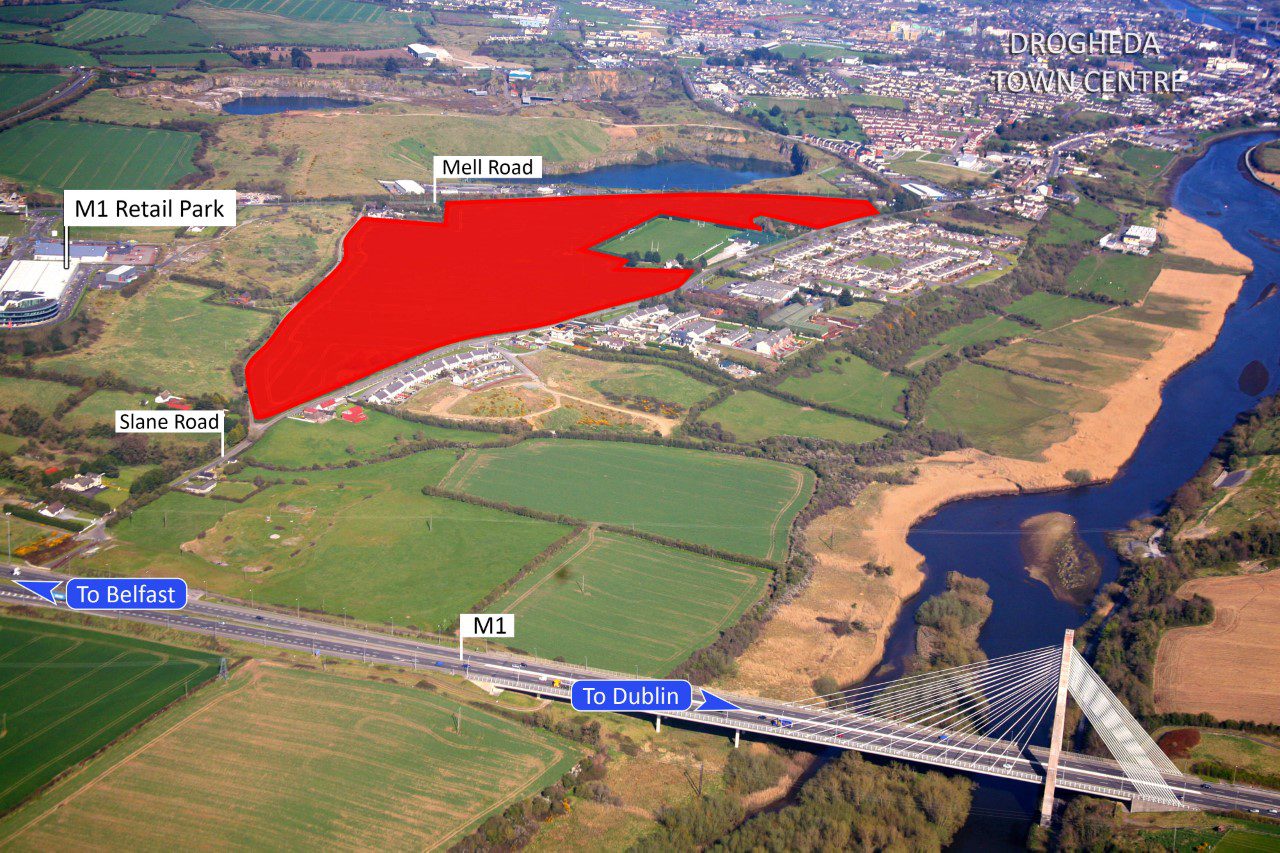
Agent Bannon is guiding a price of €3.75 million for a 46-acre landbank strategically positioned on the Slane Road between the M1 motorway and Drogheda town centre.
The property, which is in agricultural use currently, is expected to see strong interest from both residential and commercial developers, given its potential to accommodate a variety of uses. The entire holding is zoned “mixed-use (C1)” under the terms of the draft Louth County Development Plan 2021-2027. The objective of this zoning is “to provide for commercial, business and supporting residential uses”.
The final county development plan is expected to be adopted by the end of 2021. According to the draft plan, Drogheda is earmarked to further expand on its status as the largest town in Ireland with a target population of 50,000 by 2031. The town has been designated as a self-sustaining employment centre on the Dublin-Belfast Economic Corridor.
The subject site is well placed to benefit from this expected growth thanks to its location. The lands are situated on the Slane and Mell Road, with the M1 motorway (junction 10) to the northwest and Drogheda town centre to the southeast. The M1 Retail Park, which is occupied by Woodies, Smyths, Sports Direct and Dealz, is situated less than 500 metres to the northwest.
Niall Brereton, director at Bannon, said: “This is an excellent opportunity to develop a mixed-use scheme of scale, subject to planning permission, at a strategic location close to Drogheda town centre and the M1 motorway, within a town which has been identified as a regional growth centre.”
The property is being offered for sale by way of tender with a guide price of €3.75 million. The last date for receipt of tenders is noon on Thursday June 10th.
In a normal year we welcome in excess of 100 million people into Bannon managed shopping centres. As is evident from the chart below the last 12 months have been very different. That said we remain hopeful that the end is now in sight and we look forward to seeing the portfolio back to full capacity in the near future.
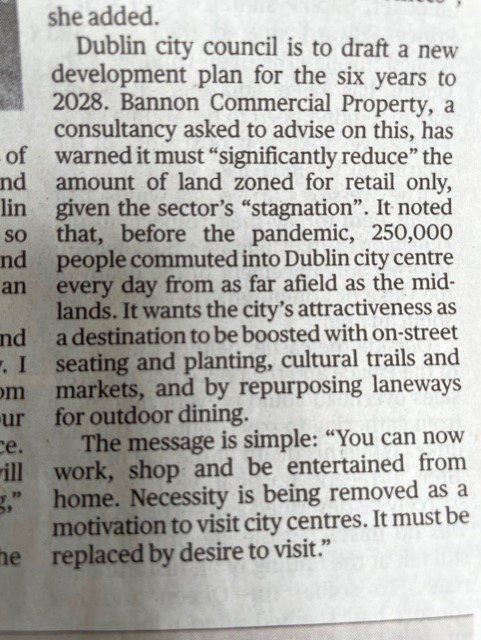 After the pandemic: in Dublin’s bare city. Our streets must be reimagined to entice visitors rather than cater to workers. Bannon advises on this in The Sunday Times.
After the pandemic: in Dublin’s bare city. Our streets must be reimagined to entice visitors rather than cater to workers. Bannon advises on this in The Sunday Times.
Covid 19 and level 5 restrictions have continued to impact the Dublin office market this quarter with just 14 transactions recorded across the sector.
As the vaccination rollout continues we are seeing a notable increase in market activity and re-activation of requirements, as companies plan for a return to the office. This is highlighted further by the increase in office accommodation reserved, which currently stands at over 500,000 sq.ft. across the capital.
 Wishing all our clients and friends a very Happy Easter from all the team at Bannon
Wishing all our clients and friends a very Happy Easter from all the team at Bannon
Despite the backdrop of Covid 19, Q1 turnover was a healthy €1.22bn, with 58% weighting to the residential sector. Strong demand in the sector for good product continues on a standing asset and forward commit basis. With restrictions on travel / viewings still in play the more traditional sectors have had a subdued quarter but should rebound later in the year. If you wish to discuss the quarter in more detail or general investment, please contact Rod Nowlan or David Carroll.
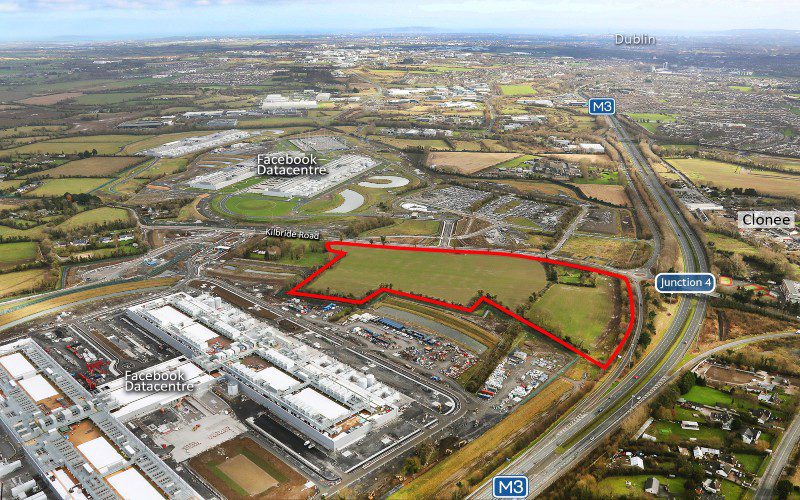
With vacancy levels for prime industrial stock reaching record lows and limited development opportunities available along the main arterial routes around the capital, agent Bannon expects to see strong demand for a 22-acre land holding fronting on to the M3 motorway.
Located next to junction 4, less than five-minutes’ drive from the M50 and 15km from Dublin city centre, the M3 Gateway site is fully serviced and offers the potential for a logistics/distribution or data-centre development of about 400,000sq ft (37,161sq m) subject to planning permission.
The land adjoining the site has in recent years been transformed by the development of two hyper-scale data centres by Facebook. Further data centres are situated nearby in Blanchardstown and Mulhuddart where Amazon Web Services is progressing a 223,000sq ft facility. The area has also proven to be popular among pharmaceutical and logistics companies, with MSD, Astellas, Helsinn Birex, Geodis and Masterlink all situated nearby.
The commuter towns of Dunboyne and Clonee are situated on the opposite side of the M3 with rail stations at Dunboyne and the M3 Parkway park-and-ride facility at Pace.
The land has direct road frontage on to both the M3 slip road and the Kilbride road. Notably services including mains drainage, water and gas supply pass through the southern portion of the site and are capped for future connection. The presence of these services is expected by the selling agent to enhance the prospects for the land when brought forward for development. The entire holding is zoned “enterprise and employment” and “warehousing and distribution” within the Meath county development plan.
The property is being offered for sale by tender on Thursday, May 6th at a guide price of €10 million.
Commenting on the sale, Niall Brereton, director at Bannon, said: “In addition to the terrific data-centre potential the lands at M3 Gateway offer institutional investors an unrivalled opportunity, subject to planning permission, to enhance the logistics/distribution allocation within their portfolios and capitalise on the significant demand amongst third-party logistics providers, pharmaceutical companies and online retailers for modern industrial stock within touching distance of the M50 and the city’s main arterial corridors.”
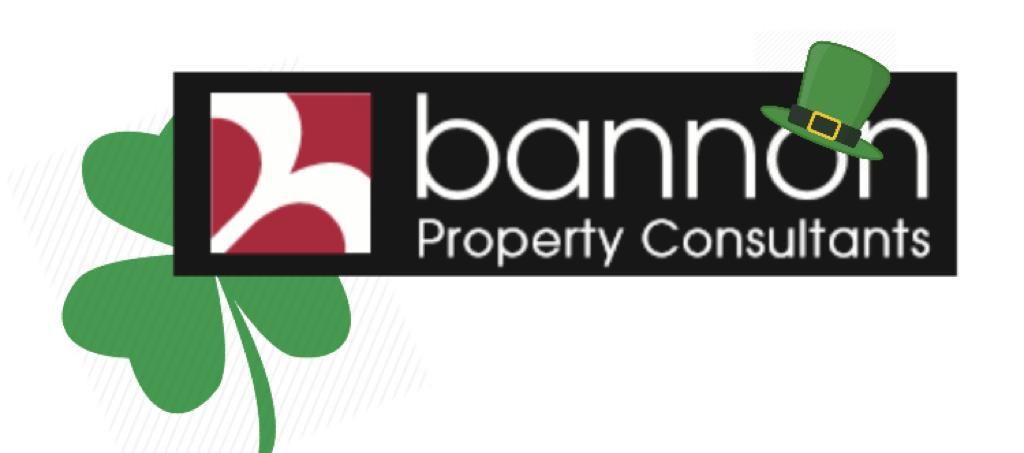 Happy St. Patrick’s Day to all our clients and friends from Ireland’s largest indigenous Commercial Property Advisor.
Happy St. Patrick’s Day to all our clients and friends from Ireland’s largest indigenous Commercial Property Advisor.
A shot from today’s Bannon town hall meeting. We simply can’t wait to get back to work with this great team in the non virtual world….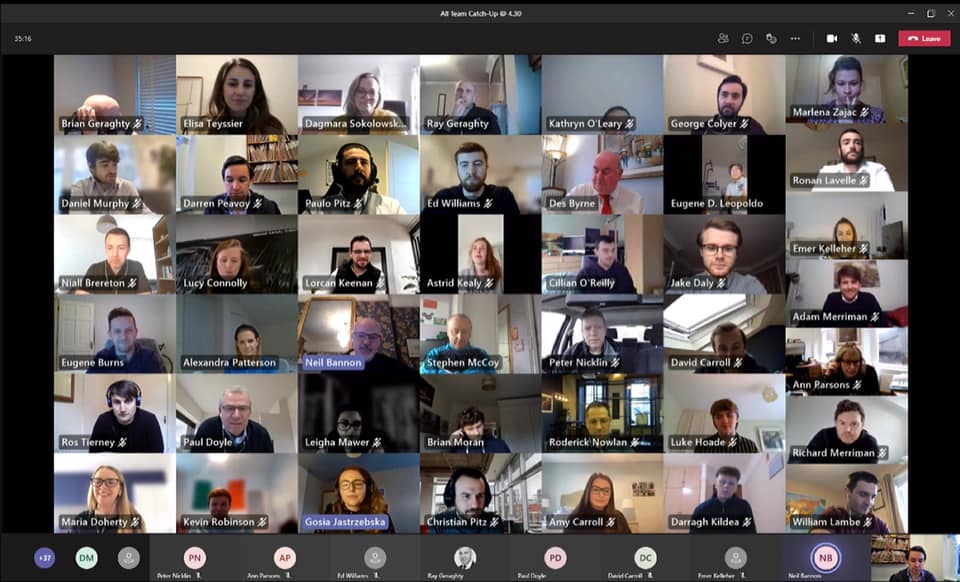
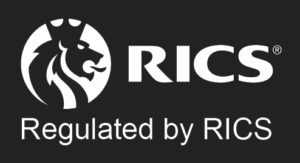


Hambleden House
19-26 Pembroke Street Lower
Dublin 2
D02 WV96
Ireland
»Map
Phone: +353 (1) 6477900
Fax: +353 (1) 6477901
Email: info@bannon.ie


| Title | Price | Status | Type | Area | Purpose | Bedrooms | Bathrooms |
|---|
